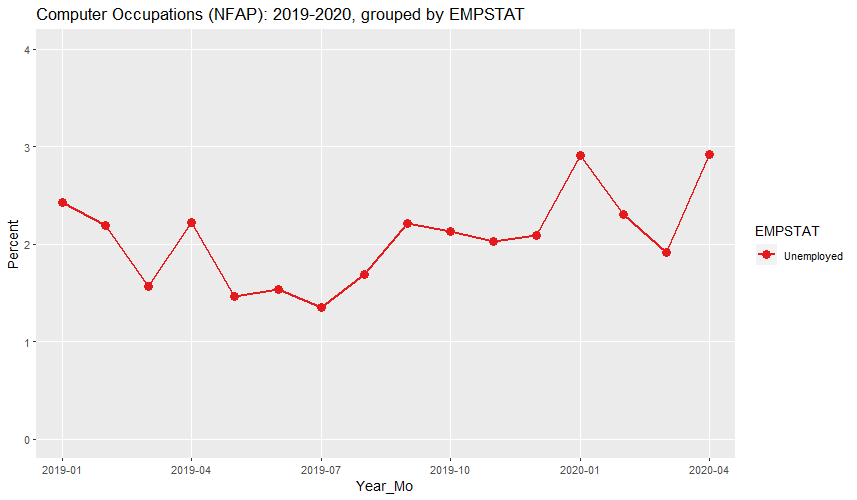
On May 18, 2020, Forbes Magazine posted an article by Stuart Anderson titled Low Unemployment Rate In Tech Harms Trump H-1B Visa Plans. That article begins:
Trump administration efforts to impose new H-1B visa restrictions face a surprising obstacle - the low unemployment rate among professionals in computer occupations in the United States. Trump officials hoped to use the current economic downturn to impose more immigration restrictions, but new data show the unemployment rate for individuals in computer occupations declined from 3% in January 2020 to 2.8% in April 2020, according to an analysis of the Bureau of Labor Statistics' Current Population Survey by the National Foundation for American Policy (NFAP).
The excerpt above links to this NFAP analysis. Under table 1 is listed the source for the 3.0 and 2.8 percent numbers and lists the precise occupations included in "Computer Occupations". It is possible to reproduce these exact same occupations in the Shiny application. Following are the results:

CURRENT POPULATION SURVEY: 2019-2020 Computer Occupations (NFAP): 2019-2020, grouped by EMPSTAT (percent) Year_Mo Count Employed Unemployed 1 2019-01 5,105,633 97.57 2.43 2 2019-02 5,376,182 97.81 2.19 3 2019-03 5,242,692 98.44 1.56 4 2019-04 5,187,993 97.78 2.22 5 2019-05 5,356,022 98.54 1.46 6 2019-06 5,325,730 98.47 1.53 7 2019-07 5,448,052 98.65 1.35 8 2019-08 5,511,756 98.31 1.69 9 2019-09 5,348,121 97.78 2.22 10 2019-10 5,208,288 97.87 2.13 11 2019-11 5,176,783 97.97 2.03 12 2019-12 5,175,842 97.91 2.09 13 2020-01 5,439,331 97.09 2.91 14 2020-02 5,515,825 97.70 2.30 15 2020-03 5,675,447 98.09 1.91 16 2020-04 5,825,750 97.08 2.92 URL parameters (short)= ?minyear=2019&maxyear=2020&STATE=&geo=NATION&occ=Computer%20Occupations%20(NFAP)&empstat=In%20labor%20force&group=EMPSTAT&sortn=2&sortdir=Ascending&decplaces=2&color=Set1&geomtype=Line%20GraphAs can be seen, the analysis appears to carefully cherry-pick January 2020 as the comparison month. In addition, Stuart Anderson's numbers differ slightly from those above. (Note: the reason for this difference was discovered and explained in the next section.) It shows that, even using the exact same occupations as the NFAP analysis, the unemployment rate was actually slightly higher at 2.92 percent in April 2020 versus 2.91 percent in January 2020. More importantly, the graph shows that the January 2020 date appears to have been carefully cherry-picked. As can be seen, January 2020 had the highest unemployment rate of any month from at least January of 2019 to March of 2020. The NFAP analysis makes absolutely no mention of this.
One other possible issue is that the occupations used in the NFAP analysis include "Computer and information systems manager". It's likely that very few of H-1B workers are in this occupation. Only 2.3 percent of the petitions listed in Table 8B on page 13 of "Characteristics of H-1B Specialty Occupation Workers, Fiscal Year 2019 Annual Report to Congress" are explicitly marked as being for managers. In any event, it would make perfect sense that the non-manager workers would be the first workers to be laid off due to the COVID-19 pandemic. Following are the unemployment numbers if managers are excluded:
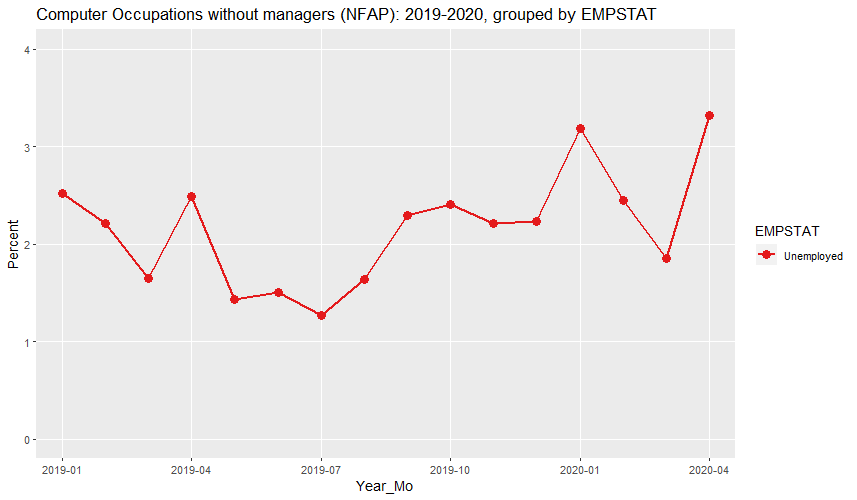
CURRENT POPULATION SURVEY: 2019-2020 Computer Occupations without managers (NFAP): 2019-2020, grouped by EMPSTAT (percent) Year_Mo Count Employed Unemployed 1 2019-01 4,514,726 97.48 2.52 2 2019-02 4,749,145 97.79 2.21 3 2019-03 4,643,742 98.35 1.65 4 2019-04 4,561,826 97.51 2.49 5 2019-05 4,686,270 98.57 1.43 6 2019-06 4,697,355 98.49 1.51 7 2019-07 4,761,931 98.73 1.27 8 2019-08 4,747,817 98.36 1.64 9 2019-09 4,632,263 97.71 2.29 10 2019-10 4,526,129 97.59 2.41 11 2019-11 4,514,026 97.79 2.21 12 2019-12 4,480,388 97.77 2.23 13 2020-01 4,771,495 96.82 3.18 14 2020-02 4,803,369 97.56 2.44 15 2020-03 4,892,415 98.15 1.85 16 2020-04 5,021,247 96.68 3.32 URL parameters (short)= ?minyear=2019&maxyear=2020&STATE=&geo=NATION&occ=Computer%20Occupations%20without%20managers%20(NFAP)&empstat=In%20labor%20force&group=EMPSTAT&sortn=2&sortdir=Ascending&decplaces=2&color=Set1&geomtype=Line%20GraphAs can be seen, the unemployment rate is now a bit higher, having risen from 3.18 percent in January 2020 to 3.32 percent in April of 2020.
In investigating the reason that unemployment peaked in January 2020, something else became evident. There have recently been a number of newspaper articles about laid-off H-1B visa holders. For example, a May 12th New York Times article was titled They Lost Their Jobs. Now They May Have to Leave the U.S.. This in itself seems to contradict the Stu Anderson's contention that the unemployment rate in tech is dropping. In any case, the CPS data does contain citizenship status. The following graph and table show the unemployment rates of the occupations looked at by NFAP, split by citizenship status.

CURRENT POPULATION SURVEY: 2017-2020
Computer Occupations (NFAP): 2017-2020, grouped by CITIZENSHIP2 and EMPSTAT (percent in CITIZENSHIP2 group)
Percent Unemployed Count Unemployed
----------------------------------------- ------------------------------------------
Year_Mo Count Non.citizen_Unemployed Citizen_Unemployed Non.citizen_Unemployed Citizen_Unemployed
1 2017-01 4,984,804 4.3 2.7 33,527.881 111,839.79
2 2017-02 4,884,569 3.0 2.1 23,073.665 87,889.66
3 2017-03 4,827,375 2.0 1.8 14,783.143 71,974.11
4 2017-04 4,891,954 3.4 2.7 25,029.396 112,632.23
5 2017-05 4,838,841 2.3 1.7 17,483.693 69,662.78
6 2017-06 4,799,142 1.6 2.5 12,606.470 99,736.74
7 2017-07 4,693,026 0.7 2.5 5,453.648 99,176.51
8 2017-08 4,829,429 2.4 2.7 18,702.965 109,555.26
9 2017-09 4,871,080 2.4 3.4 18,343.915 140,054.46
10 2017-10 4,913,458 3.0 2.7 20,487.493 113,193.37
11 2017-11 5,008,906 2.8 2.3 19,724.613 100,889.62
12 2017-12 5,065,524 4.4 1.6 28,465.368 71,736.51
13 2018-01 5,092,995 3.3 1.9 25,026.121 81,085.06
14 2018-02 5,293,158 2.7 2.2 22,414.838 96,443.16
15 2018-03 5,256,627 1.7 1.2 14,352.817 51,084.89
16 2018-04 5,099,725 1.8 2.1 14,628.887 90,750.23
17 2018-05 5,133,953 1.8 2.2 15,277.811 93,137.40
18 2018-06 5,062,406 0.9 1.9 7,326.142 82,869.29
19 2018-07 5,057,976 2.1 1.9 17,337.156 81,382.39
20 2018-08 5,110,765 1.0 2.2 8,525.532 93,067.26
21 2018-09 4,948,750 1.3 1.9 10,777.401 77,851.48
22 2018-10 5,082,571 1.9 1.9 15,449.240 81,930.87
23 2018-11 5,085,295 1.3 2.0 10,057.227 86,525.78
24 2018-12 5,168,445 1.6 1.9 13,497.875 83,613.88
25 2019-01 5,105,633 1.9 2.5 15,531.565 108,645.45
26 2019-02 5,376,182 3.2 2.0 28,677.721 89,174.00
27 2019-03 5,242,692 1.2 1.6 10,056.712 71,974.07
28 2019-04 5,187,993 1.1 2.4 8,813.088 106,330.78
29 2019-05 5,356,022 1.0 1.5 8,090.813 70,035.18
30 2019-06 5,325,730 1.4 1.6 12,365.930 69,145.43
31 2019-07 5,448,052 0.5 1.5 4,318.273 69,367.35
32 2019-08 5,511,756 0.5 1.9 4,038.619 89,188.60
33 2019-09 5,348,121 0.7 2.5 5,701.291 112,850.34
34 2019-10 5,208,288 0.1 2.5 827.926 110,225.61
35 2019-11 5,176,783 0.9 2.3 7,639.578 97,283.81
36 2019-12 5,175,842 0.6 2.4 5,037.152 103,176.08
37 2020-01 5,439,331 4.4 2.6 36,614.497 121,826.71
38 2020-02 5,515,825 1.9 2.4 14,875.878 112,050.82
39 2020-03 5,675,447 1.1 2.1 9,958.555 98,667.30
40 2020-04 5,825,750 1.7 3.1 14,738.768 155,083.93
URL parameters (short)=
?maxyear=2020&STATE=&units=Percent%20in%20group&geo=NATION&occ=Computer%20Occupations%20(NFAP)&empstat=In%20labor%20force&group=CITIZENSHIP2|EMPSTAT&sortn=2&sortdir=Ascending&ymax=5&color=Set1&geomtype=Line%20Graph
As can be seen, the spike in unemployment in January was chiefly among non-citizens. In fact, extending the timeline of the graph back through 2017 reveals that there seems to have been a peak near the beginning of each year since then. The peak was in December of 2017, and February of 2019, both within one month of January. This would seem to merit further investigation. In any event, this would indicate that it would be very misleading to use January 2020 as an indication of the unemployment level of U.S. citizens in computer occupations. At 3.1 percent, their unemployment rate in April of 2020 was the highest level since it reached 3.4 percent in September of 2017. In addition, the table above shows that over 50,000 U.S. computer workers appear to have lost their jobs in April.
The following graph and table show the same information but with managers removed.

CURRENT POPULATION SURVEY: 2017-2020
Computer Occupations without managers (NFAP): 2017-2020, grouped by CITIZENSHIP2 and EMPSTAT (percent in CITIZENSHIP2 group)
Percent Unemployed Count Unemployed
----------------------------------------- ------------------------------------------
Year_Mo Count Non.citizen_Unemployed Citizen_Unemployed Non.citizen_Unemployed Citizen_Unemployed
1 2017-01 4,334,216 4.6 2.5 33,527.881 89,004.36
2 2017-02 4,214,306 3.2 2.2 23,073.665 77,145.73
3 2017-03 4,130,673 2.2 1.9 14,783.143 64,868.82
4 2017-04 4,234,893 3.1 2.6 20,801.971 92,445.26
5 2017-05 4,192,623 2.6 1.6 17,483.693 55,696.10
6 2017-06 4,208,824 1.2 2.4 9,268.567 82,858.90
7 2017-07 4,120,717 0.8 2.5 5,453.648 84,532.61
8 2017-08 4,210,661 2.0 2.7 14,956.991 95,076.55
9 2017-09 4,226,438 2.2 3.3 15,338.376 117,042.20
10 2017-10 4,258,792 3.2 2.5 20,487.493 91,205.83
11 2017-11 4,372,668 3.1 2.5 19,724.613 91,788.72
12 2017-12 4,418,939 4.8 1.7 28,465.368 66,123.35
13 2018-01 4,486,574 3.5 2.0 24,028.261 77,922.73
14 2018-02 4,680,772 2.8 2.3 21,446.335 89,539.80
15 2018-03 4,667,536 1.7 1.2 13,391.596 48,178.24
16 2018-04 4,502,789 1.9 1.9 13,741.349 72,695.99
17 2018-05 4,534,162 1.9 2.1 15,277.811 76,758.52
18 2018-06 4,430,653 1.0 1.8 7,326.142 65,845.77
19 2018-07 4,433,493 2.2 1.8 17,337.156 67,718.99
20 2018-08 4,499,733 1.0 2.4 8,525.532 86,474.93
21 2018-09 4,341,764 1.4 2.1 10,777.401 74,024.38
22 2018-10 4,399,934 2.1 1.7 15,449.240 60,953.53
23 2018-11 4,440,410 1.3 1.8 10,057.227 67,299.05
24 2018-12 4,479,564 1.8 1.9 13,497.875 72,819.67
25 2019-01 4,514,726 2.0 2.6 15,531.565 98,272.27
26 2019-02 4,749,145 3.3 2.0 28,360.496 76,772.04
27 2019-03 4,643,742 1.2 1.7 9,751.318 66,835.80
28 2019-04 4,561,826 1.1 2.8 8,510.555 105,042.30
29 2019-05 4,686,270 1.1 1.5 8,090.813 59,105.56
30 2019-06 4,697,355 1.5 1.5 12,365.930 58,337.47
31 2019-07 4,761,931 0.6 1.4 4,318.273 56,294.35
32 2019-08 4,747,817 0.5 1.8 4,038.619 73,608.71
33 2019-09 4,632,263 0.8 2.6 5,701.291 100,580.44
34 2019-10 4,526,129 0.1 2.9 827.926 108,241.43
35 2019-11 4,514,026 0.9 2.5 7,639.578 92,255.45
36 2019-12 4,480,388 0.7 2.5 5,037.152 94,793.08
37 2020-01 4,771,495 4.7 2.9 36,614.497 115,245.73
38 2020-02 4,803,369 2.0 2.5 14,875.878 102,458.38
39 2020-03 4,892,415 1.2 2.0 9,958.555 80,674.32
40 2020-04 5,021,247 1.9 3.6 14,738.768 151,844.89
URL parameters (short)=
?maxyear=2020&STATE=&units=Percent%20in%20group&geo=NATION&occ=Computer%20Occupations%20without%20managers%20(NFAP)&empstat=In%20labor%20force&group=CITIZENSHIP2|EMPSTAT&sortn=2&sortdir=Ascending&ymax=5&color=Set1&geomtype=Line%20Graph
As can be seen, the 3.6 percent for U.S. workers in April 2020 was the highest unemployment rate since before 2017. Of course, it makes sense that computer workers have not been hit as hard as non-tech workers since much of their work can be done remotely, at least for a while. But if you look at just the unemployment rate of U.S. computer workers, it is clear that their unemployment rate went up in April of 2020.
As mentioned in the prior section, it was not possible to exactly reproduce Stuart Anderson's numbers using CPS data from IPUMS. I sent an email to the Forbes corrections department at corrections@forbes.com , explaining the problems that I had found with Stuart Anderson's numbers, and providing a link to this page. I also asked for Stuart Anderson to "provide links to the exact numbers by which he calculated the 3.0 and 2.8 percent numbers in his Table 1". I got the following reply:
Hi - thanks for reading Forbes.com and writing in. I've sent your note to the writer of the piece for review.
I received this reply on May 27, 2020 and have since asked for an update several times. I have gotten no response. Hence, neither Forbes nor Stuart Anderson have been of any help in finding Stuart's original source. Fortunately, I was able to eventually find the source on my own. It turns out that the raw CPS data is originally posted on the U.S. Census website. This same raw data is posted on the NBER website, along with the same data in Stata .dta files. The .dta files for the desired months can be downloaded and the following R program will read and process them:
# NFAP Computer occupations include (pre-2020 in parentheses):
# 1005 Computer and information research scientist
# 0110 Computer and information systems manager
# 1400 Computer hardware engineer
# 1106 Computer network architect
# 1010 Computer programmer
# 1050 Computer support specialist
# 1006 Computer systems analyst
# 1065 Database administrator and architect (1060 Database administrators)
# 1007 Information security analyst
# 1410 Electrical and electronics engineer
# 1105 Network and computer systems administrator
# 1021 Software developer (1020 Software developers, applications and systems software)
# 1022 Software quality assurance analyst and tester (1020 above)
# 1032 Web and digital interface designer (1030 Web developers)
# 1031 Web developer (1030 above)
# OCCUPATION CODES: 2011-2019 at https://cps.ipums.org/cps/codes/occ_20112019_codes.shtml
# OCCUPATION CODES: 2020+ at https://cps.ipums.org/cps/codes/occ_2020_codes.shtml
# Download data files from https://www.census.gov/data/datasets/time-series/demo/cps/cps-basic.html
# Unzip files to get .dat file in local directory; from feb 2020 on, copy .dat file from cpspb\prod\data
library("tidyverse")
library("haven")
mnth <- c("jan","feb","mar","apr","may","jun","jul","aug","sep","oct","nov","dec")
start <- c(860,172,613,393)
end <- c(863,173,622,394)
nms <- c("peio1ocd","prcitshp","pwsswgt","prempnot")
minyear <- 2017 # START CHANGABLE VARIABLES
maxyear <- 2020
maxmnth <- 5
xaxistp <- 4
dplaces <- 1
ymax <- 5
managers <- TRUE # END CHANGABLE VARIABLES
if (managers){
mandesc <- "with managers"
outfile <- sprintf("cps_nfap20%02d", maxmnth)
}else{
mandesc <- "without managers"
outfile <- sprintf("cps_nfap_womgr20%02d", maxmnth)
}
if (!exists("dd")){
for (year in minyear:maxyear){
for (month in 1:12){
year_mo <- sprintf("%04d-%02d", year, month)
filename <- paste0(mnth[month],year %% 100,"pub.dat")
if (!file.exists(filename)){
break
}
print(paste0("BEFORE read ", filename))
tt <- read_fwf(filename, fwf_positions(start, end, nms), col_types = "iiii")
print(paste0(" AFTER read ", filename))
if (year >= 2020){
if (managers){
occs <- c(1005,0110,1400,1106,1010,1050,1006,1065,1007,1410,1105,1021,1022,1032,1031)
}else{
occs <- c(1005,1400,1106,1010,1050,1006,1065,1007,1410,1105,1021,1022,1032,1031)
}
}else{
if (managers){
occs <- c(1005,0110,1400,1106,1010,1050,1006,1060,1007,1410,1105,1020,1030)
}else{
occs <- c(1005,1400,1106,1010,1050,1006,1060,1007,1410,1105,1020,1030)
}
}
all <- tt[tt$peio1ocd %in% occs,]
cit <- all[all$prcitshp != 5,]
non <- all[all$prcitshp == 5,]
all_unemp <- sum(all$pwsswgt[all$prempnot == 2]) / 10000
cit_unemp <- sum(cit$pwsswgt[cit$prempnot == 2]) / 10000
non_unemp <- sum(non$pwsswgt[non$prempnot == 2]) / 10000
all_ilf <- sum(all$pwsswgt[all$prempnot == 1]) / 10000 + all_unemp
cit_ilf <- sum(cit$pwsswgt[cit$prempnot == 1]) / 10000 + cit_unemp
non_ilf <- sum(non$pwsswgt[non$prempnot == 1]) / 10000 + non_unemp
all_urate <- 100 * all_unemp / all_ilf
cit_urate <- 100 * cit_unemp / cit_ilf
non_urate <- 100 * non_unemp / non_ilf
cc <- data.frame(year_mo,
non_ilf, cit_ilf, all_ilf,
non_unemp, cit_unemp, all_unemp,
non_urate, cit_urate, all_urate)
if (!exists("dd")){
dd <- cc
}
else {
dd <- rbind(dd, cc)
}
}
}
}
pp <- data.frame(dd$year_mo, dd$all_ilf, dd$non_urate, dd$cit_urate, dd$all_urate,
dd$non_unemp, dd$cit_unemp, dd$all_unemp)
names(pp) <- c("year_mo","labor_force","non_rate","cit_rate","all_rate",
"non_count","cit_count","all_count")
write_csv(pp, paste0(outfile, ".csv"))
pp$labor_force <- format(pp$labor_force, big.mark=",", scientific=FALSE)
for (i in 3:5){
pp[,i] <- format(round(pp[,i], dplaces), nsmall = dplaces)
}
for (i in 6:8){
pp[,i] <- format(round(pp[,i]), big.mark=",", scientific=FALSE)
}
title <- paste("Computer Occupations",mandesc,"(NFAP): 2017-2020, grouped by CITIZENSHIP")
cat(paste0(title,"\n\n"))
print(pp)
ee <- data.frame(dd$year_mo, dd$non_urate, dd$cit_urate, dd$all_urate)
vars <- c("Non-citizen Unemployed","Citizen Unemployed","All Unemployed")
names(ee) <- c("year_mo", vars)
mm <- gather(ee, "key", "value", vars)
mm$key <- factor(mm$key, levels = vars)
every_nth = function(n) { # function for labeling axis
return(function(x) {x[c(TRUE, rep(FALSE, n - 1))]})
}
png(paste0(outfile,".png"), width = 1500, height = 500)
gg <- ggplot(data=mm, aes(x=year_mo,y=value,group=key)) +
geom_point(aes(color=key,shape=key), size=3, alpha=1.0) +
geom_line(aes(color=key), size=1, alpha=1.0) +
scale_color_manual(values = c("red", "blue", "green")) +
scale_x_discrete(breaks = every_nth(n = xaxistp)) +
coord_cartesian(ylim=c(0, ymax)) +
scale_y_continuous(breaks = seq(0, 6, 1), minor_breaks = NULL) +
ggtitle(title) +
xlab("Year_Mo\nSource: See http://econdataus.com/cps03covid19.htm") +
ylab("Percent in CITIZENSHIP group")
print(gg)
dev.off()
X11(width = 24, height = 12)
print(gg)
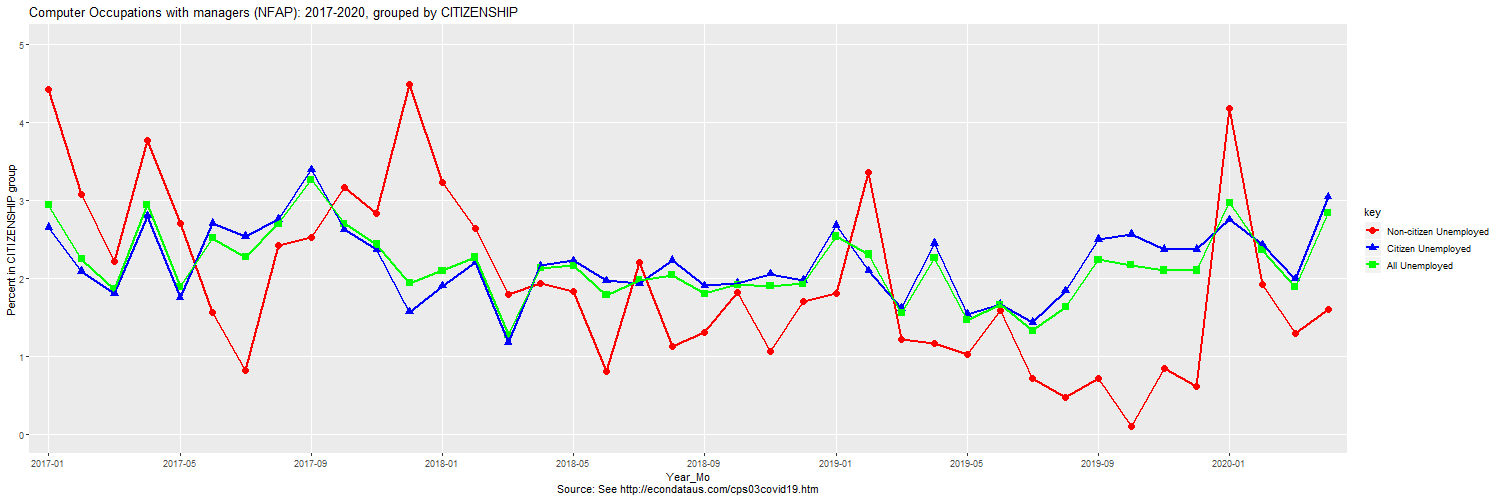
Computer Occupations with managers (NFAP): 2017-2020, grouped by CITIZENSHIP year_mo labor_force non_rate cit_rate all_rate non_count cit_count all_count 1 2017-01 5,083,329 4.4 2.7 2.9 35,608 113,686 149,294 2 2017-02 5,007,023 3.1 2.1 2.2 24,350 88,110 112,460 3 2017-03 4,921,265 2.2 1.8 1.9 16,225 75,456 91,681 4 2017-04 4,983,520 3.8 2.8 2.9 27,594 119,085 146,679 5 2017-05 4,887,519 2.7 1.7 1.9 19,922 72,621 92,543 6 2017-06 4,871,279 1.6 2.7 2.5 12,476 110,183 122,659 7 2017-07 4,777,019 0.8 2.5 2.3 6,121 102,340 108,461 8 2017-08 4,887,736 2.4 2.8 2.7 19,337 112,815 132,153 9 2017-09 4,941,581 2.5 3.4 3.3 19,055 142,162 161,217 10 2017-10 4,973,484 3.2 2.6 2.7 21,667 112,810 134,477 11 2017-11 5,097,665 2.8 2.4 2.4 20,012 104,162 124,173 12 2017-12 5,168,565 4.5 1.6 1.9 29,454 70,786 100,240 13 2018-01 5,204,071 3.2 1.9 2.1 24,481 84,624 109,104 14 2018-02 5,386,050 2.6 2.2 2.3 21,772 100,409 122,182 15 2018-03 5,341,738 1.8 1.2 1.3 15,174 52,967 68,141 16 2018-04 5,187,960 1.9 2.2 2.1 15,372 95,131 110,503 17 2018-05 5,241,516 1.8 2.2 2.2 15,664 97,719 113,383 18 2018-06 5,144,426 0.8 2.0 1.8 6,414 85,569 91,983 19 2018-07 5,142,346 2.2 1.9 2.0 18,644 83,032 101,676 20 2018-08 5,156,508 1.1 2.2 2.0 10,035 95,221 105,256 21 2018-09 5,004,165 1.3 1.9 1.8 10,777 79,570 90,347 22 2018-10 5,169,572 1.8 1.9 1.9 14,532 84,735 99,267 23 2018-11 5,186,986 1.1 2.1 1.9 8,745 89,765 98,510 24 2018-12 5,234,781 1.7 2.0 1.9 14,178 86,988 101,166 25 2019-01 5,154,654 1.8 2.7 2.5 15,205 115,648 130,854 26 2019-02 5,429,520 3.4 2.1 2.3 30,370 94,890 125,260 27 2019-03 5,271,519 1.2 1.6 1.6 10,295 71,602 81,897 28 2019-04 5,221,387 1.2 2.4 2.3 9,135 108,711 117,846 29 2019-05 5,413,793 1.0 1.5 1.5 7,897 71,472 79,369 30 2019-06 5,406,565 1.6 1.7 1.7 13,725 76,018 89,743 31 2019-07 5,533,182 0.7 1.4 1.3 6,052 67,442 73,495 32 2019-08 5,630,362 0.5 1.8 1.6 4,024 87,974 91,998 33 2019-09 5,410,845 0.7 2.5 2.2 5,701 115,425 121,126 34 2019-10 5,311,873 0.1 2.6 2.2 828 114,536 115,363 35 2019-11 5,301,418 0.8 2.4 2.1 7,978 103,430 111,408 36 2019-12 5,269,303 0.6 2.4 2.1 5,037 105,728 110,765 37 2020-01 5,540,113 4.2 2.8 3.0 35,387 129,266 164,653 38 2020-02 5,602,755 1.9 2.4 2.4 14,942 117,460 132,402 39 2020-03 5,794,298 1.3 2.0 1.9 11,458 97,810 109,268 40 2020-04 5,955,976 1.6 3.1 2.8 13,588 155,760 169,348As can be seen in the above table, the R program exactly reproduces Stuart's results. The green line in the graph shows that January 2020 appears to be cherry-picked to show a decline in unemployment. In any event, the blue line shows that unemployment rose even from this cherry-picked date if one correctly looks at unemployed citizens, the group that would be affected by the import of non-citizen workers.
As seen in the CPS data from IPUMS, the spike in unemployment in January was chiefly among non-citizens. In fact, extending the timeline of the graph back through 2017 reveals that there seems to have been a peak near the beginning of each year since then. The peak was in December of 2017, and February of 2019, both within one month of January. This would seem to merit further investigation. In any event, this would indicate that it would be very misleading to use January 2020 as an indication of the unemployment level of U.S. citizens in computer occupations. At 3.1 percent, their unemployment rate in April of 2020 was the highest level since it reached 3.4 percent in September of 2017. In addition, the table above shows that over 50,000 U.S. computer workers appear to have lost their jobs in April.
By setting the variable managers to FALSE in line 28 and rerunning the R program, one can obtain the results if managers are excluded. That results in the following graph and output: The following graph and table show the same information but with managers removed.
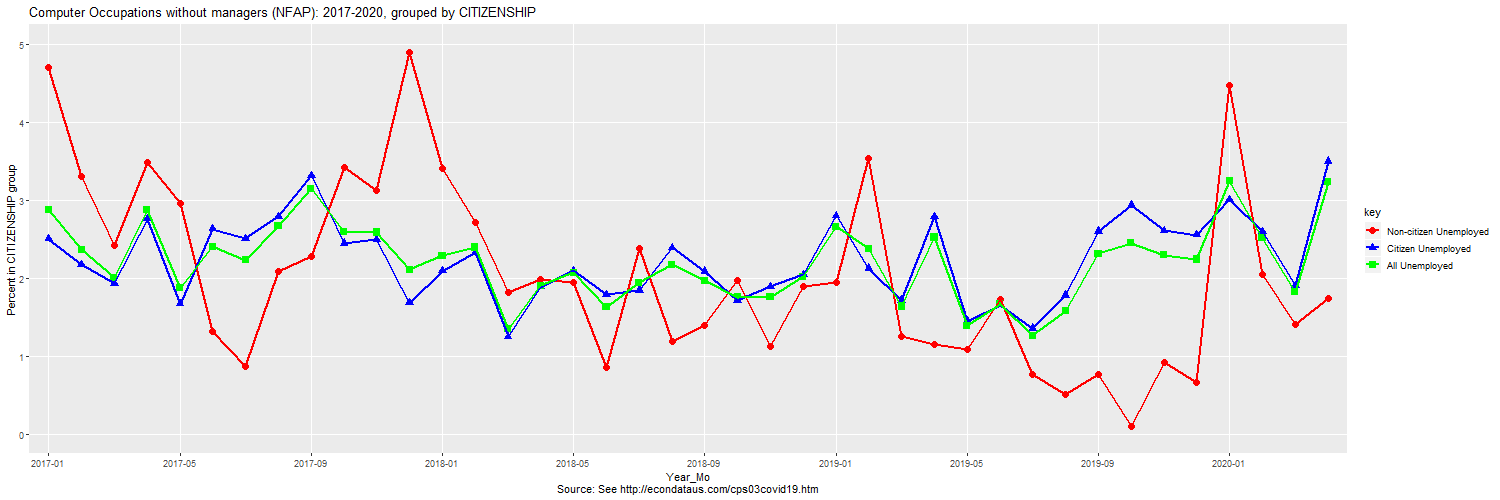
Computer Occupations without managers (NFAP): 2017-2020, grouped by CITIZENSHIP year_mo labor_force non_rate cit_rate all_rate non_count cit_count all_count 1 2017-01 4,418,127 4.7 2.5 2.9 35,608 91,698 127,306 2 2017-02 4,322,500 3.3 2.2 2.4 24,350 78,051 102,401 3 2017-03 4,207,951 2.4 1.9 2.0 16,225 68,350 84,576 4 2017-04 4,321,363 3.5 2.8 2.9 23,367 100,829 124,196 5 2017-05 4,250,604 3.0 1.7 1.9 19,922 59,850 79,771 6 2017-06 4,287,531 1.3 2.6 2.4 9,768 93,305 103,073 7 2017-07 4,202,769 0.9 2.5 2.2 6,121 87,852 93,973 8 2017-08 4,267,456 2.1 2.8 2.7 15,591 98,404 113,995 9 2017-09 4,292,611 2.3 3.3 3.1 16,049 119,094 135,144 10 2017-10 4,312,437 3.4 2.4 2.6 21,667 90,165 111,831 11 2017-11 4,443,990 3.1 2.5 2.6 20,012 95,061 115,072 12 2017-12 4,507,124 4.9 1.7 2.1 29,454 65,765 95,219 13 2018-01 4,583,073 3.4 2.1 2.3 23,571 81,442 105,013 14 2018-02 4,765,832 2.7 2.3 2.4 20,764 93,474 114,238 15 2018-03 4,750,518 1.8 1.3 1.3 14,192 49,864 64,056 16 2018-04 4,577,494 2.0 1.9 1.9 14,438 72,742 87,180 17 2018-05 4,627,878 2.0 2.1 2.1 15,664 80,350 96,014 18 2018-06 4,505,213 0.9 1.8 1.6 6,414 67,154 73,567 19 2018-07 4,505,654 2.4 1.8 1.9 18,644 68,871 87,515 20 2018-08 4,539,820 1.2 2.4 2.2 10,035 88,629 98,664 21 2018-09 4,382,343 1.4 2.1 2.0 10,777 75,482 86,259 22 2018-10 4,474,589 2.0 1.7 1.8 14,532 64,238 78,770 23 2018-11 4,526,183 1.1 1.9 1.8 8,745 70,920 79,665 24 2018-12 4,533,034 1.9 2.0 2.0 14,178 77,412 91,591 25 2019-01 4,553,058 2.0 2.8 2.7 15,205 105,905 121,111 26 2019-02 4,795,655 3.5 2.1 2.4 29,775 84,258 114,033 27 2019-03 4,674,276 1.3 1.7 1.6 9,725 66,947 76,672 28 2019-04 4,589,232 1.2 2.8 2.5 8,489 107,422 115,912 29 2019-05 4,748,410 1.1 1.5 1.4 7,897 58,381 66,278 30 2019-06 4,776,756 1.7 1.7 1.7 13,725 65,999 79,724 31 2019-07 4,855,038 0.8 1.4 1.3 6,052 55,382 61,434 32 2019-08 4,864,940 0.5 1.8 1.6 4,024 72,860 76,884 33 2019-09 4,695,728 0.8 2.6 2.3 5,701 103,151 108,853 34 2019-10 4,634,934 0.1 2.9 2.5 828 112,861 113,689 35 2019-11 4,633,479 0.9 2.6 2.3 7,978 98,507 106,485 36 2019-12 4,565,457 0.7 2.6 2.2 5,037 97,358 102,395 37 2020-01 4,861,975 4.5 3.0 3.2 35,387 122,510 157,897 38 2020-02 4,873,710 2.0 2.6 2.5 14,942 107,730 122,672 39 2020-03 4,977,364 1.4 1.9 1.8 11,458 79,417 90,875 40 2020-04 5,132,250 1.7 3.5 3.2 13,588 152,521 166,109As can be seen, the 3.5 percent for U.S. workers in April 2020 was the highest unemployment rate since before 2017. Of course, it makes sense that computer workers have not been hit as hard as non-tech workers since much of their work can be done remotely, at least for a while. But if you look at just the unemployment rate of U.S. computer workers, it is clear that their unemployment rate went up in April of 2020, even from the cherry-picked month of January 2020.
Regarding the slight difference between the CPS data that is initially released and the CPS data on IPUMS, this IPUMS CPS page states the following:
IPUMS CPS unharmonized variables are original CPS data packaged for accessibility and utility. Regular IPUMS CPS variables are harmonized for comparability across time. Similar concepts are given consistent codes across months and years, unknown and NIU categories are coded consistently, and any unexpected values are recoded. IPUMS CPS unharmonized variables correspond directly to the original public use datasets made available by the Census Bureau and the Bureau of Labor Statistics.
Hence, the IPUMS CPS data seems to be slightly better for looking at data across time. However, the original public use datasets do have an advantage that they can be directly downloaded and processed via an R program like the one above. In any event, both sets of data show that Stuart Anderson's claim that the unemployment rate for individuals in computer occupations has declined is clearly false. Media would do well to demand that studies they cite have precise sources, are peer-reviewed, and/or are reproducible. Forbes appears to have demanded none of these from Stuart Anderson and his NFAP study.
On June 11, 2020, Forbes Magazine posted another article by Stuart Anderson titled Unemployment Rate For Computer Occupations Fell In May. That article begins:
The Trump administration hopes to use the economic fallout from the coronavirus pandemic to impose new immigration restrictions on H-1B visa holders and international students, but reality is undermining its case. The unemployment rate for individuals in computer occupations declined from 3% in January 2020 (before the pandemic spread in the U.S.) to 2.8% in April 2020, and fell again to 2.5% in May 2020, according to an analysis of the Bureau of Labor Statistics' Current Population Survey by the National Foundation for American Policy (NFAP). The unemployment rate in computer occupations has been stable and, in fact, falling.
The excerpt above links to this NFAP analysis. This analysis is an update through May of his prior one described above. Unfortunately, it's not yet possible to reproduce the May numbers using the Stata .dta files in the NBER website since those files have not yet been updated. Fortunately, it was relatively easy to rewrite the prior R program to read the original raw data files on the Census website. Following is the new R program that can read and process the raw files:
# NFAP Computer occupations include (pre-2020 in parentheses):
# 1005 Computer and information research scientist
# 0110 Computer and information systems manager
# 1400 Computer hardware engineer
# 1106 Computer network architect
# 1010 Computer programmer
# 1050 Computer support specialist
# 1006 Computer systems analyst
# 1065 Database administrator and architect (1060 Database administrators)
# 1007 Information security analyst
# 1410 Electrical and electronics engineer
# 1105 Network and computer systems administrator
# 1021 Software developer (1020 Software developers, applications and systems software)
# 1022 Software quality assurance analyst and tester (1020 above)
# 1032 Web and digital interface designer (1030 Web developers)
# 1031 Web developer (1030 above)
# OCCUPATION CODES: 2011-2019 at https://cps.ipums.org/cps/codes/occ_20112019_codes.shtml
# OCCUPATION CODES: 2020+ at https://cps.ipums.org/cps/codes/occ_2020_codes.shtml
# Download data files from https://www.census.gov/data/datasets/time-series/demo/cps/cps-basic.html
# Unzip files to get .dat file in local directory; from feb 2020 on, copy .dat file from cpspb\prod\data
library("tidyverse")
library("haven")
mnth <- c("jan","feb","mar","apr","may","jun","jul","aug","sep","oct","nov","dec")
start <- c(860,172,613,393)
end <- c(863,173,622,394)
nms <- c("peio1ocd","prcitshp","pwsswgt","prempnot")
minyear <- 2017 # START CHANGABLE VARIABLES
maxyear <- 2020
maxmnth <- 5
xaxistp <- 4
dplaces <- 1
ymax <- 5
managers <- TRUE # END CHANGABLE VARIABLES
if (managers){
mandesc <- "with managers"
outfile <- sprintf("cps_nfap20%02d", maxmnth)
}else{
mandesc <- "without managers"
outfile <- sprintf("cps_nfap_womgr20%02d", maxmnth)
}
if (!exists("dd")){
for (year in minyear:maxyear){
for (month in 1:12){
year_mo <- sprintf("%04d-%02d", year, month)
filename <- paste0(mnth[month],year %% 100,"pub.dat")
if (!file.exists(filename)){
break
}
print(paste0("BEFORE read ", filename))
tt <- read_fwf(filename, fwf_positions(start, end, nms), col_types = "iiii")
print(paste0(" AFTER read ", filename))
if (year >= 2020){
if (managers){
occs <- c(1005,0110,1400,1106,1010,1050,1006,1065,1007,1410,1105,1021,1022,1032,1031)
}else{
occs <- c(1005,1400,1106,1010,1050,1006,1065,1007,1410,1105,1021,1022,1032,1031)
}
}else{
if (managers){
occs <- c(1005,0110,1400,1106,1010,1050,1006,1060,1007,1410,1105,1020,1030)
}else{
occs <- c(1005,1400,1106,1010,1050,1006,1060,1007,1410,1105,1020,1030)
}
}
all <- tt[tt$peio1ocd %in% occs,]
cit <- all[all$prcitshp != 5,]
non <- all[all$prcitshp == 5,]
all_unemp <- sum(all$pwsswgt[all$prempnot == 2]) / 10000
cit_unemp <- sum(cit$pwsswgt[cit$prempnot == 2]) / 10000
non_unemp <- sum(non$pwsswgt[non$prempnot == 2]) / 10000
all_ilf <- sum(all$pwsswgt[all$prempnot == 1]) / 10000 + all_unemp
cit_ilf <- sum(cit$pwsswgt[cit$prempnot == 1]) / 10000 + cit_unemp
non_ilf <- sum(non$pwsswgt[non$prempnot == 1]) / 10000 + non_unemp
all_urate <- 100 * all_unemp / all_ilf
cit_urate <- 100 * cit_unemp / cit_ilf
non_urate <- 100 * non_unemp / non_ilf
cc <- data.frame(year_mo,
non_ilf, cit_ilf, all_ilf,
non_unemp, cit_unemp, all_unemp,
non_urate, cit_urate, all_urate)
if (!exists("dd")){
dd <- cc
}
else {
dd <- rbind(dd, cc)
}
}
}
}
pp <- data.frame(dd$year_mo, dd$all_ilf, dd$non_urate, dd$cit_urate, dd$all_urate,
dd$non_unemp, dd$cit_unemp, dd$all_unemp)
names(pp) <- c("year_mo","labor_force","non_rate","cit_rate","all_rate",
"non_count","cit_count","all_count")
write_csv(pp, paste0(outfile, ".csv"))
pp$labor_force <- format(pp$labor_force, big.mark=",", scientific=FALSE)
for (i in 3:5){
pp[,i] <- format(round(pp[,i], dplaces), nsmall = dplaces)
}
for (i in 6:8){
pp[,i] <- format(round(pp[,i]), big.mark=",", scientific=FALSE)
}
title <- paste("Computer Occupations",mandesc,"(NFAP): 2017-2020, grouped by CITIZENSHIP")
cat(paste0(title,"\n\n"))
print(pp)
ee <- data.frame(dd$year_mo, dd$non_urate, dd$cit_urate, dd$all_urate)
vars <- c("Non-citizen Unemployed","Citizen Unemployed","All Unemployed")
names(ee) <- c("year_mo", vars)
mm <- gather(ee, "key", "value", vars)
mm$key <- factor(mm$key, levels = vars)
every_nth = function(n) { # function for labeling axis
return(function(x) {x[c(TRUE, rep(FALSE, n - 1))]})
}
png(paste0(outfile,".png"), width = 1500, height = 500)
gg <- ggplot(data=mm, aes(x=year_mo,y=value,group=key)) +
geom_point(aes(color=key,shape=key), size=3, alpha=1.0) +
geom_line(aes(color=key), size=1, alpha=1.0) +
scale_color_manual(values = c("red", "blue", "green")) +
scale_x_discrete(breaks = every_nth(n = xaxistp)) +
coord_cartesian(ylim=c(0, ymax)) +
scale_y_continuous(breaks = seq(0, 6, 1), minor_breaks = NULL) +
ggtitle(title) +
xlab("Year_Mo\nSource: See http://econdataus.com/cps03covid19.htm") +
ylab("Percent in CITIZENSHIP group")
print(gg)
dev.off()
X11(width = 24, height = 12)
print(gg)
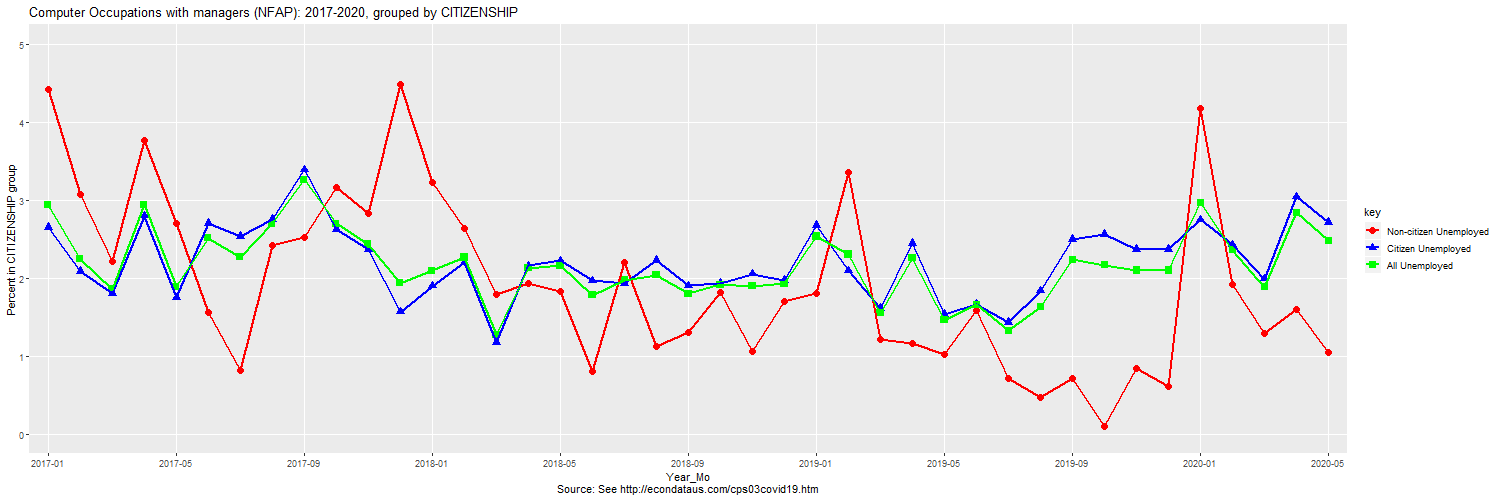
Computer Occupations with managers (NFAP): 2017-2020, grouped by CITIZENSHIP year_mo labor_force non_rate cit_rate all_rate non_count cit_count all_count 1 2017-01 5,083,329 4.4 2.7 2.9 35,608 113,686 149,294 2 2017-02 5,007,023 3.1 2.1 2.2 24,350 88,110 112,460 3 2017-03 4,921,265 2.2 1.8 1.9 16,225 75,456 91,681 4 2017-04 4,983,520 3.8 2.8 2.9 27,594 119,085 146,679 5 2017-05 4,887,519 2.7 1.7 1.9 19,922 72,621 92,543 6 2017-06 4,871,279 1.6 2.7 2.5 12,476 110,183 122,659 7 2017-07 4,777,019 0.8 2.5 2.3 6,121 102,340 108,461 8 2017-08 4,887,736 2.4 2.8 2.7 19,337 112,815 132,153 9 2017-09 4,941,581 2.5 3.4 3.3 19,055 142,162 161,217 10 2017-10 4,973,484 3.2 2.6 2.7 21,667 112,810 134,477 11 2017-11 5,097,665 2.8 2.4 2.4 20,012 104,162 124,173 12 2017-12 5,168,565 4.5 1.6 1.9 29,454 70,786 100,240 13 2018-01 5,204,071 3.2 1.9 2.1 24,481 84,624 109,104 14 2018-02 5,386,050 2.6 2.2 2.3 21,772 100,409 122,182 15 2018-03 5,341,738 1.8 1.2 1.3 15,174 52,967 68,141 16 2018-04 5,187,960 1.9 2.2 2.1 15,372 95,131 110,503 17 2018-05 5,241,516 1.8 2.2 2.2 15,664 97,719 113,383 18 2018-06 5,144,426 0.8 2.0 1.8 6,414 85,569 91,983 19 2018-07 5,142,346 2.2 1.9 2.0 18,644 83,032 101,676 20 2018-08 5,156,508 1.1 2.2 2.0 10,035 95,221 105,256 21 2018-09 5,004,165 1.3 1.9 1.8 10,777 79,570 90,347 22 2018-10 5,169,572 1.8 1.9 1.9 14,532 84,735 99,267 23 2018-11 5,186,986 1.1 2.1 1.9 8,745 89,765 98,510 24 2018-12 5,234,781 1.7 2.0 1.9 14,178 86,988 101,166 25 2019-01 5,154,654 1.8 2.7 2.5 15,205 115,648 130,854 26 2019-02 5,429,520 3.4 2.1 2.3 30,370 94,890 125,260 27 2019-03 5,271,519 1.2 1.6 1.6 10,295 71,602 81,897 28 2019-04 5,221,387 1.2 2.4 2.3 9,135 108,711 117,846 29 2019-05 5,413,793 1.0 1.5 1.5 7,897 71,472 79,369 30 2019-06 5,406,565 1.6 1.7 1.7 13,725 76,018 89,743 31 2019-07 5,533,182 0.7 1.4 1.3 6,052 67,442 73,495 32 2019-08 5,630,362 0.5 1.8 1.6 4,024 87,974 91,998 33 2019-09 5,410,845 0.7 2.5 2.2 5,701 115,425 121,126 34 2019-10 5,311,873 0.1 2.6 2.2 828 114,536 115,363 35 2019-11 5,301,418 0.8 2.4 2.1 7,978 103,430 111,408 36 2019-12 5,269,303 0.6 2.4 2.1 5,037 105,728 110,765 37 2020-01 5,540,113 4.2 2.8 3.0 35,387 129,266 164,653 38 2020-02 5,602,755 1.9 2.4 2.4 14,942 117,460 132,402 39 2020-03 5,794,298 1.3 2.0 1.9 11,458 97,810 109,268 40 2020-04 5,955,976 1.6 3.1 2.8 13,588 155,760 169,348 41 2020-05 6,030,322 1.0 2.7 2.5 8,921 140,820 149,741As can be seen in the above table, the R program exactly reproduces Stuart's results. The green line in the graph shows that January 2020 appears to be cherry-picked to show a decline in unemployment. In any event, the blue line and table shows that unemployment declined only a tenth of one percent from this cherry-picked date if one correctly looks at unemployed citizens, the group that would be affected by the import of non-citizen workers.
The graph also shows that the spike in unemployment in January was chiefly among non-citizens. As previously mentioned, extending the timeline of the graph back through 2017 reveals that there seems to have been a peak near the beginning of each year since then. The peak was in December of 2017, and February of 2019, both within one month of January. This would seem to merit further investigation. In any event, this would indicate that it would be very misleading to use January 2020 as an indication of the unemployment level of U.S. citizens in computer occupations. Except for January, the citizen unemployment rate of 2.7 percent in May of 2020 was the highest level since it reached a similar level in January of 2019 and, before that, June of 2017. Also, it's worth noting that, except for April, the 140,000 citizen computer workers unemployed in May is higher than any number since September of 2017.
By setting the variable managers to FALSE in line 34 and rerunning the R program, one can obtain the results if managers are excluded. That results in the following graph and output: The following graph and table show the same information but with managers removed.

Computer Occupations without managers (NFAP): 2017-2020, grouped by CITIZENSHIP year_mo labor_force non_rate cit_rate all_rate non_count cit_count all_count 1 2017-01 4,418,127 4.7 2.5 2.9 35,608 91,698 127,306 2 2017-02 4,322,500 3.3 2.2 2.4 24,350 78,051 102,401 3 2017-03 4,207,951 2.4 1.9 2.0 16,225 68,350 84,576 4 2017-04 4,321,363 3.5 2.8 2.9 23,367 100,829 124,196 5 2017-05 4,250,604 3.0 1.7 1.9 19,922 59,850 79,771 6 2017-06 4,287,531 1.3 2.6 2.4 9,768 93,305 103,073 7 2017-07 4,202,769 0.9 2.5 2.2 6,121 87,852 93,973 8 2017-08 4,267,456 2.1 2.8 2.7 15,591 98,404 113,995 9 2017-09 4,292,611 2.3 3.3 3.1 16,049 119,094 135,144 10 2017-10 4,312,437 3.4 2.4 2.6 21,667 90,165 111,831 11 2017-11 4,443,990 3.1 2.5 2.6 20,012 95,061 115,072 12 2017-12 4,507,124 4.9 1.7 2.1 29,454 65,765 95,219 13 2018-01 4,583,073 3.4 2.1 2.3 23,571 81,442 105,013 14 2018-02 4,765,832 2.7 2.3 2.4 20,764 93,474 114,238 15 2018-03 4,750,518 1.8 1.3 1.3 14,192 49,864 64,056 16 2018-04 4,577,494 2.0 1.9 1.9 14,438 72,742 87,180 17 2018-05 4,627,878 2.0 2.1 2.1 15,664 80,350 96,014 18 2018-06 4,505,213 0.9 1.8 1.6 6,414 67,154 73,567 19 2018-07 4,505,654 2.4 1.8 1.9 18,644 68,871 87,515 20 2018-08 4,539,820 1.2 2.4 2.2 10,035 88,629 98,664 21 2018-09 4,382,343 1.4 2.1 2.0 10,777 75,482 86,259 22 2018-10 4,474,589 2.0 1.7 1.8 14,532 64,238 78,770 23 2018-11 4,526,183 1.1 1.9 1.8 8,745 70,920 79,665 24 2018-12 4,533,034 1.9 2.0 2.0 14,178 77,412 91,591 25 2019-01 4,553,058 2.0 2.8 2.7 15,205 105,905 121,111 26 2019-02 4,795,655 3.5 2.1 2.4 29,775 84,258 114,033 27 2019-03 4,674,276 1.3 1.7 1.6 9,725 66,947 76,672 28 2019-04 4,589,232 1.2 2.8 2.5 8,489 107,422 115,912 29 2019-05 4,748,410 1.1 1.5 1.4 7,897 58,381 66,278 30 2019-06 4,776,756 1.7 1.7 1.7 13,725 65,999 79,724 31 2019-07 4,855,038 0.8 1.4 1.3 6,052 55,382 61,434 32 2019-08 4,864,940 0.5 1.8 1.6 4,024 72,860 76,884 33 2019-09 4,695,728 0.8 2.6 2.3 5,701 103,151 108,853 34 2019-10 4,634,934 0.1 2.9 2.5 828 112,861 113,689 35 2019-11 4,633,479 0.9 2.6 2.3 7,978 98,507 106,485 36 2019-12 4,565,457 0.7 2.6 2.2 5,037 97,358 102,395 37 2020-01 4,861,975 4.5 3.0 3.2 35,387 122,510 157,897 38 2020-02 4,873,710 2.0 2.6 2.5 14,942 107,730 122,672 39 2020-03 4,977,364 1.4 1.9 1.8 11,458 79,417 90,875 40 2020-04 5,132,250 1.7 3.5 3.2 13,588 152,521 166,109 41 2020-05 5,208,495 1.1 3.1 2.8 8,921 135,082 144,003As can be seen, the 3.1 percent for U.S. workers in May 2020 was, except for April, the highest unemployment rate since September of 2017. Of course, it makes sense that computer workers have not been hit as hard as non-tech workers since much of their work can be done remotely, at least for a while. But if you look at just the unemployment rate of U.S. computer workers, it is clear that their unemployment rate is slightly up, even from the cherry-picked month of January 2020.
One small improvement in the updated Forbes article and NFAP analysis is that they show the lower unemployment numbers for February and March of 2020 in Table 2, providing a little bit of context for the January number. The article states: "Table 2 shows the unemployment rate for individuals in computer occupations in 2020 has been fairly consistent, according to the analysis, at 3% in January 2020, 2.4% in February, 1.9% in March, 2.8% in April and 2.5% in May." But, as mentioned above, the lead paragraph states: "The unemployment rate in computer occupations has been stable and, in fact, falling." That statement is followed by Table 1 which shows only January, April, and May. Why does the article leave out February and March here? Is it that two additional month would hopelessly overload the reader? They need to warm up on 3 months in Table 1 so that they can handle 5 months in Table 2? Or could it be that the writer is aware that most readers won't read much beyond the first paragraph? In any case, the article and analysis still make the serious mistake of including non-citizen computer workers in the analysis. It makes no sense to include the unemployment of H-1B workers in measuring their effect on citizen workers.
Finally, the article makes a major point of comparing the unemployment rates of computer occupations to the much higher unemployment rates of all other occupations. This is a serious mistake. Suppose that U.S. employers are discriminating against U.S. workers due to race, gender, and/or age or because they perceive those workers to be more independent and/or higher paid. What will those workers do? If they need income to survive, younger workers will likely accept jobs in other, lower-paid fields while continuing to look for computer work. Older workers may essentially give up and move to another field or retire. Both the younger and older workers will disappear from the unemployment roles. A worker who is unemployed from ALL occupations is a very different matter. They will show up in the overall unemployment rate and in the unemployment rate of whichever occupation they identify as their current one. Hence, it's very much a mistake to treat the unemployment rate of a specific occupation the same as the overall unemployment rate. It may be useful in measuring an economic shock to an occupation that causes sudden, temporary unemployment. But it likely will not be able to detect if there is systemic bias against classes of workers and that those workers are driven out of the field.
In any event, media would do well to demand that studies they cite have precise sources, are peer-reviewed, and/or are reproducible. This would have allowed the problems of the NFAP study to be identified much sooner and would likely deter the cherry-picking that was present in the first NFAP study and in Table 1 of this one.
Investigating Stuart Anderson's Choices of Computer Occupations
I became aware that the unemployment situation looks much different for the major occupation group of "Computer and Mathematical Occupations" described on this U.S. Bureau of Labor Statistics web page. Following is a revised version of the prior R program that will also look at this and several other categories of occupations.
# NFAP Computer occupations include (pre-2020 in parentheses):
# 0110 Computer and information systems manager
# 1005 Computer and information research scientist
# 1006 Computer systems analyst
# 1007 Information security analyst
# 1010 Computer programmer
# 1021 Software developer (1020 Software developers, applications and systems software)
# 1022 Software quality assurance analyst and tester (1020 above)
# 1031 Web developer (1030 Web developers)
# 1032 Web and digital interface designer (1030 above)
# 1050 Computer support specialist
# 1065 Database administrator and architect (1060 Database administrators)
# 1105 Network and computer systems administrator
# 1106 Computer network architect
# not included in NFAP Computer occupations (pre-2020 in parentheses):
# 1108 Computer occupations, all other (1107)
# 1200 Actuaries
# 1210 Mathematicians (pre-2020 only)
# 1220 Operations research analysts
# 1230 Statisticians (pre-2020 only)
# 1240 Other mathematical science occupations
# added to NFAP Computer occupations (pre-2020 in parentheses):
# 1400 Computer hardware engineer
# 1410 Electrical and electronics engineer
# OCCUPATION CODES: 2011-2019 at https://cps.ipums.org/cps/codes/occ_20112019_codes.shtml
# OCCUPATION CODES: 2020+ at https://cps.ipums.org/cps/codes/occ_2020_codes.shtml
# Download data files from https://www.census.gov/data/datasets/time-series/demo/cps/cps-basic.html
# Unzip files to get .dat file in local directory; from feb 2020 on, copy .dat file from cpspb\prod\data
library("tidyverse")
mnth <- c("jan","feb","mar","apr","may","jun","jul","aug","sep","oct","nov","dec")
start <- c(860,172,613,393)
end <- c(863,173,622,394)
nms <- c("peio1ocd","prcitshp","pwsswgt","prempnot")
# START CHANGABLE VARIABLES
minyear <- 2017
maxyear <- 2020
maxmnth <- 5
xaxistp <- 4
dplaces <- 1
ymax <- 5
occt <- "Computer and Mathematical Occupations"
#occt <- "Computer Occupations, including 'all other'"
#occt <- "Computer Occupations, excluding 'all other'"
#occt <- "Computer Occupations, all other"
#occt <- "Computer Hardware or Electric Engineer (NFAP)"
#occt <- "Computer Occupations with managers (NFAP)"
#occt <- "Computer Occupations without managers (NFAP)"
# END CHANGABLE VARIABLES
if (!exists("dd")){
for (year in minyear:maxyear){
for (month in 1:12){
year_mo <- sprintf("%04d-%02d", year, month)
filename <- paste0(mnth[month],year %% 100,"pub.dat")
if (!file.exists(filename)){
break
}
print(paste0("BEFORE read ", filename))
tt <- read_fwf(filename, fwf_positions(start, end, nms), col_types = "iiii")
print(paste0(" AFTER read ", filename))
title <- paste0(occt,": ",minyear,"-",maxyear,", grouped by CITIZENSHIP")
if (occt == "Computer and Mathematical Occupations"){
all <- tt[tt$peio1ocd >= 1000 & tt$peio1ocd <= 1299,]
outfile <- sprintf("cps_cm20%02d", maxmnth)
}
else if (occt == "Computer Occupations, including 'all other'"){
all <- tt[tt$peio1ocd >= 1000 & tt$peio1ocd <= 1199,]
outfile <- sprintf("cps_cin_ao20%02d", maxmnth)
}
else if (occt == "Computer Occupations, excluding 'all other'"){
all <- tt[tt$peio1ocd >= 1000 & tt$peio1ocd <= 1106,]
outfile <- sprintf("cps_cex_ao20%02d", maxmnth)
}
else if (occt == "Computer Occupations, all other"){
all <- tt[tt$peio1ocd >= 1107 & tt$peio1ocd <= 1108,]
outfile <- sprintf("cps_c_ao20%02d", maxmnth)
ymax <- 0
}
else if (occt == "Computer Hardware or Electric Engineer (NFAP)"){
all <- tt[tt$peio1ocd >= 1400 & tt$peio1ocd <= 1410,]
outfile <- sprintf("cps_nfap_eng20%02d", maxmnth)
ymax <- 0
}
else if (occt == "Computer Occupations with managers (NFAP)"){
if (year >= 2020){
occs <- c(1005,0110,1400,1106,1010,1050,1006,1065,1007,1410,1105,1021,1022,1032,1031)
}else{
occs <- c(1005,0110,1400,1106,1010,1050,1006,1060,1007,1410,1105,1020,1030)
}
all <- tt[tt$peio1ocd %in% occs,]
outfile <- sprintf("cps_nfap20%02d", maxmnth)
}
else if (occt == "Computer Occupations without managers (NFAP)"){
if (year >= 2020){
occs <- c(1005,1400,1106,1010,1050,1006,1065,1007,1410,1105,1021,1022,1032,1031)
}else{
occs <- c(1005,1400,1106,1010,1050,1006,1060,1007,1410,1105,1020,1030)
}
all <- tt[tt$peio1ocd %in% occs,]
outfile <- sprintf("cps_nfap_womgr20%02d", maxmnth)
}
else{
all <- tt
outfile <- sprintf("cps_unk%02d", maxmnth)
ymax <- 0
}
cit <- all[all$prcitshp != 5,]
non <- all[all$prcitshp == 5,]
all_unemp <- sum(all$pwsswgt[all$prempnot == 2]) / 10000
cit_unemp <- sum(cit$pwsswgt[cit$prempnot == 2]) / 10000
non_unemp <- sum(non$pwsswgt[non$prempnot == 2]) / 10000
all_ilf <- sum(all$pwsswgt[all$prempnot == 1]) / 10000 + all_unemp
cit_ilf <- sum(cit$pwsswgt[cit$prempnot == 1]) / 10000 + cit_unemp
non_ilf <- sum(non$pwsswgt[non$prempnot == 1]) / 10000 + non_unemp
all_urate <- 100 * all_unemp / all_ilf
cit_urate <- 100 * cit_unemp / cit_ilf
non_urate <- 100 * non_unemp / non_ilf
cc <- data.frame(year_mo,
non_ilf, cit_ilf, all_ilf,
non_unemp, cit_unemp, all_unemp,
non_urate, cit_urate, all_urate)
if (!exists("dd")){
dd <- cc
}
else {
dd <- rbind(dd, cc)
}
}
}
}
pp <- data.frame(dd$year_mo, dd$all_ilf, dd$non_urate, dd$cit_urate, dd$all_urate,
dd$non_unemp, dd$cit_unemp, dd$all_unemp)
names(pp) <- c("year_mo","labor_force","non_rate","cit_rate","all_rate",
"non_count","cit_count","all_count")
write_csv(pp, paste0(outfile, ".csv"))
pp$labor_force <- format(pp$labor_force, big.mark=",", scientific=FALSE)
for (i in 3:5){
pp[,i] <- format(round(pp[,i], dplaces), nsmall = dplaces)
}
for (i in 6:8){
pp[,i] <- format(round(pp[,i]), big.mark=",", scientific=FALSE)
}
cat(paste0(title,"\n\n"))
print(pp)
ee <- data.frame(dd$year_mo, dd$non_urate, dd$cit_urate, dd$all_urate)
vars <- c("Non-citizen Unemployed","Citizen Unemployed","All Unemployed")
names(ee) <- c("year_mo", vars)
mm <- gather(ee, "key", "value", vars)
mm$key <- factor(mm$key, levels = vars)
every_nth = function(n) { # function for labeling axis
return(function(x) {x[c(TRUE, rep(FALSE, n - 1))]})
}
png(paste0(outfile,".png"), width = 1500, height = 500)
gg <- ggplot(data=mm, aes(x=year_mo,y=value,group=key))
gg <- gg + geom_point(aes(color=key,shape=key), size=3, alpha=1.0)
gg <- gg + geom_line(aes(color=key), size=1, alpha=1.0)
gg <- gg + scale_color_manual(values = c("red", "blue", "green"))
gg <- gg + scale_x_discrete(breaks = every_nth(n = xaxistp))
if (ymax > 0){
gg <- gg + coord_cartesian(ylim=c(0, ymax))
gg <- gg + scale_y_continuous(breaks = seq(0, ymax, 1), minor_breaks = NULL)
}
gg <- gg + ggtitle(title)
gg <- gg + xlab("Year_Mo\nSource: See http://econdataus.com/cps03covid19.htm")
gg <- gg + ylab("Percent in CITIZENSHIP group")
print(gg)
dev.off()
X11(width = 24, height = 12)
print(gg)
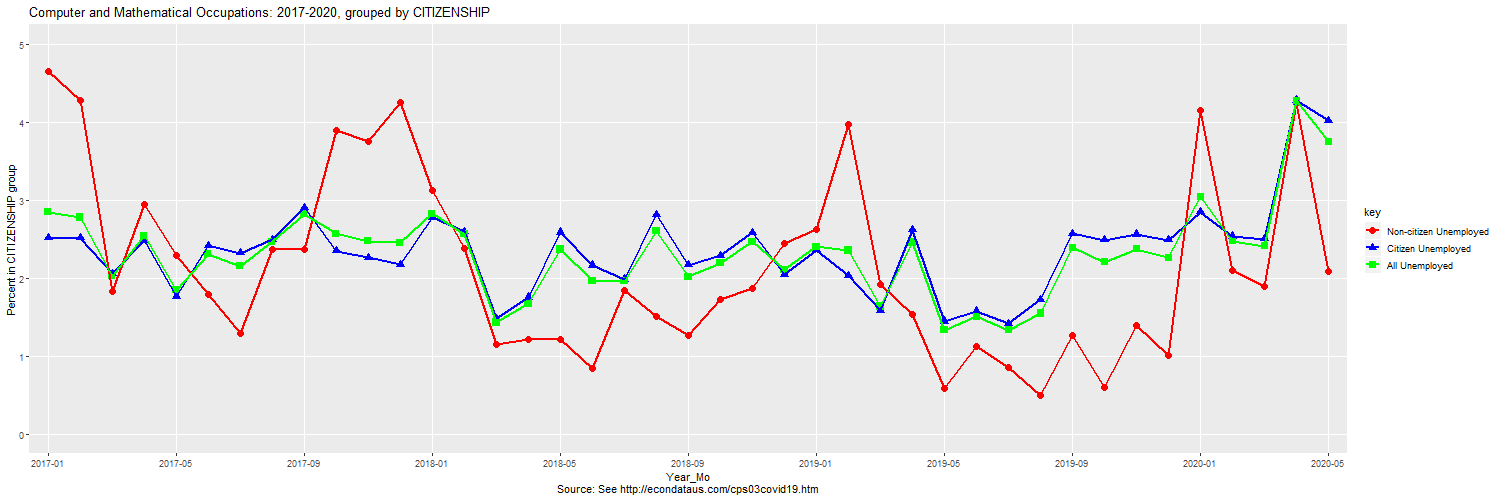
Computer and Mathematical Occupations: 2017-2020, grouped by CITIZENSHIP year_mo labor_force non_rate cit_rate all_rate non_count cit_count all_count 1 2017-01 4,925,576 4.7 2.5 2.8 35,608 104,685 140,294 2 2017-02 4,864,465 4.3 2.5 2.8 31,264 104,063 135,326 3 2017-03 4,765,096 1.8 2.1 2.0 12,341 84,248 96,590 4 2017-04 4,891,047 3.0 2.5 2.5 19,728 104,781 124,508 5 2017-05 4,746,049 2.3 1.8 1.8 16,358 71,373 87,731 6 2017-06 4,875,990 1.8 2.4 2.3 14,447 98,361 112,808 7 2017-07 4,809,441 1.3 2.3 2.2 10,290 93,324 103,614 8 2017-08 4,913,918 2.4 2.5 2.5 19,160 102,362 121,522 9 2017-09 5,050,421 2.4 2.9 2.8 19,137 123,427 142,563 10 2017-10 4,957,960 3.9 2.4 2.6 27,929 99,744 127,673 11 2017-11 5,192,807 3.8 2.3 2.5 27,252 101,252 128,505 12 2017-12 5,188,650 4.3 2.2 2.5 29,454 97,973 127,427 13 2018-01 5,362,693 3.1 2.8 2.8 23,571 128,228 151,799 14 2018-02 5,423,726 2.4 2.6 2.6 18,948 120,349 139,297 15 2018-03 5,313,240 1.2 1.5 1.4 9,243 67,028 76,272 16 2018-04 5,166,433 1.2 1.8 1.7 9,279 77,374 86,653 17 2018-05 5,191,494 1.2 2.6 2.4 10,227 112,899 123,126 18 2018-06 5,065,522 0.8 2.2 2.0 6,414 93,293 99,707 19 2018-07 5,158,464 1.8 2.0 2.0 14,578 86,841 101,420 20 2018-08 5,266,121 1.5 2.8 2.6 13,183 123,910 137,093 21 2018-09 5,137,030 1.3 2.2 2.0 10,777 93,123 103,900 22 2018-10 5,257,394 1.7 2.3 2.2 14,803 100,761 115,564 23 2018-11 5,343,396 1.9 2.6 2.5 16,354 115,727 132,081 24 2018-12 5,320,720 2.4 2.1 2.1 20,028 92,355 112,383 25 2019-01 5,278,705 2.6 2.4 2.4 22,450 104,668 127,118 26 2019-02 5,539,388 4.0 2.0 2.4 36,758 93,901 130,659 27 2019-03 5,319,788 1.9 1.6 1.6 16,341 70,966 87,307 28 2019-04 5,313,380 1.5 2.6 2.5 11,893 118,885 130,779 29 2019-05 5,384,440 0.6 1.4 1.3 4,205 67,604 71,809 30 2019-06 5,508,139 1.1 1.6 1.5 9,049 74,240 83,288 31 2019-07 5,671,678 0.9 1.4 1.3 6,843 69,041 75,884 32 2019-08 5,783,949 0.5 1.7 1.6 4,024 85,715 89,740 33 2019-09 5,570,780 1.3 2.6 2.4 9,879 123,347 133,225 34 2019-10 5,460,774 0.6 2.5 2.2 4,976 115,596 120,573 35 2019-11 5,406,374 1.4 2.6 2.4 12,467 115,833 128,300 36 2019-12 5,416,640 1.0 2.5 2.3 8,370 114,302 122,672 37 2020-01 5,815,714 4.2 2.9 3.0 35,909 141,194 177,103 38 2020-02 5,817,381 2.1 2.5 2.5 16,986 127,166 144,152 39 2020-03 5,792,608 1.9 2.5 2.4 16,499 123,260 139,759 40 2020-04 6,012,218 4.2 4.3 4.3 35,035 222,237 257,271 41 2020-05 6,002,364 2.1 4.0 3.7 17,633 207,430 225,062
As can be seen, the unemployment rate of citizen computer and math workers rose more than a percent in April and remained elevated at 4 percent in May. I initially assumed that this might be due to Mathematical Occupations. The following graph and table removes those occupations and looks only at computer occupations.
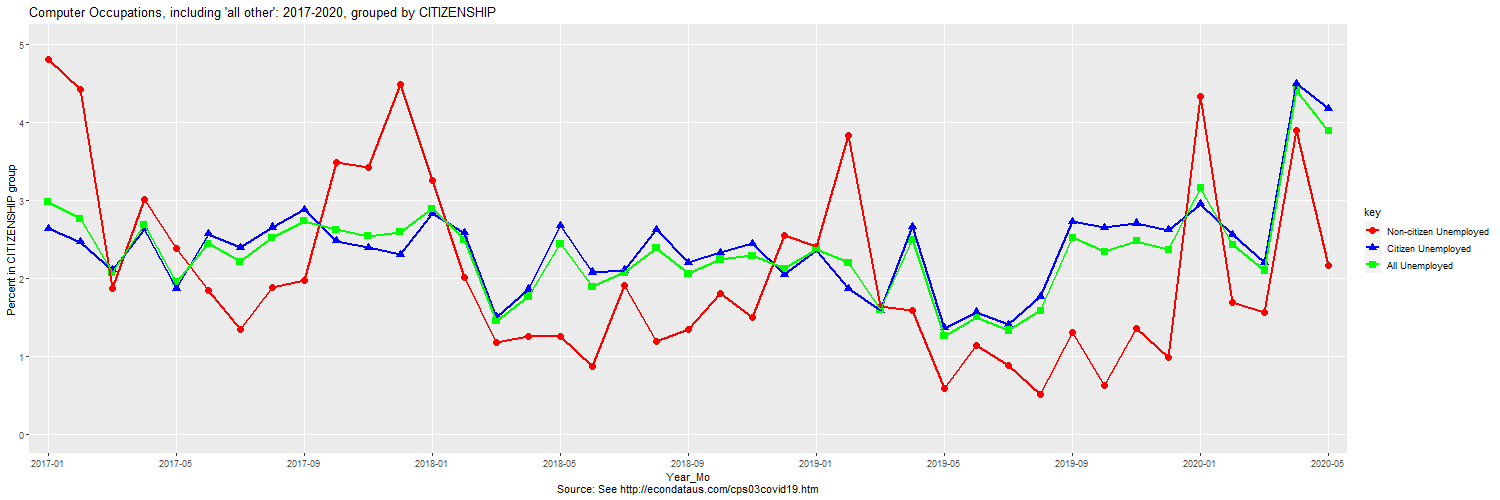
Computer Occupations, including 'all other': 2017-2020, grouped by CITIZENSHIP year_mo labor_force non_rate cit_rate all_rate non_count cit_count all_count 1 2017-01 4,685,816 4.8 2.6 3.0 35,608 103,944 139,552 2 2017-02 4,631,068 4.4 2.5 2.8 31,264 96,769 128,032 3 2017-03 4,498,666 1.9 2.1 2.1 12,341 80,915 93,256 4 2017-04 4,634,233 3.0 2.6 2.7 19,728 104,781 124,508 5 2017-05 4,498,814 2.4 1.9 2.0 16,358 71,373 87,731 6 2017-06 4,598,185 1.8 2.6 2.4 14,447 98,025 112,472 7 2017-07 4,512,675 1.3 2.4 2.2 10,290 89,706 99,996 8 2017-08 4,623,816 1.9 2.7 2.5 14,694 101,987 116,681 9 2017-09 4,716,498 2.0 2.9 2.7 15,191 113,710 128,901 10 2017-10 4,672,188 3.5 2.5 2.6 23,943 98,765 122,708 11 2017-11 4,917,446 3.4 2.4 2.5 23,590 101,252 124,842 12 2017-12 4,909,810 4.5 2.3 2.6 29,454 97,973 127,427 13 2018-01 5,091,390 3.3 2.8 2.9 23,571 123,616 147,187 14 2018-02 5,123,750 2.0 2.6 2.5 15,408 112,427 127,835 15 2018-03 5,049,461 1.2 1.5 1.5 9,243 64,204 73,447 16 2018-04 4,897,968 1.3 1.9 1.8 9,279 77,374 86,653 17 2018-05 4,944,899 1.3 2.7 2.4 10,227 110,594 120,821 18 2018-06 4,795,027 0.9 2.1 1.9 6,414 84,368 90,782 19 2018-07 4,891,323 1.9 2.1 2.1 14,578 86,841 101,420 20 2018-08 4,997,171 1.2 2.6 2.4 10,035 109,150 119,185 21 2018-09 4,866,778 1.3 2.2 2.1 10,777 89,525 100,303 22 2018-10 4,995,703 1.8 2.3 2.2 14,803 97,273 112,077 23 2018-11 5,055,289 1.5 2.4 2.3 12,677 103,087 115,764 24 2018-12 5,029,231 2.6 2.0 2.1 20,028 86,884 106,913 25 2019-01 4,947,938 2.4 2.4 2.4 19,223 98,116 117,339 26 2019-02 5,157,313 3.8 1.9 2.2 33,523 79,948 113,471 27 2019-03 4,965,726 1.6 1.6 1.6 13,177 66,263 79,440 28 2019-04 4,955,578 1.6 2.7 2.5 11,893 111,920 123,813 29 2019-05 5,061,264 0.6 1.4 1.3 4,205 59,402 63,607 30 2019-06 5,209,893 1.1 1.6 1.5 9,049 69,116 78,165 31 2019-07 5,386,494 0.9 1.4 1.3 6,843 64,925 71,768 32 2019-08 5,439,314 0.5 1.8 1.6 4,024 82,135 86,160 33 2019-09 5,279,188 1.3 2.7 2.5 9,879 123,347 133,225 34 2019-10 5,153,748 0.6 2.6 2.3 4,976 115,596 120,573 35 2019-11 5,142,270 1.4 2.7 2.5 11,913 115,492 127,405 36 2019-12 5,147,469 1.0 2.6 2.4 7,918 113,941 121,859 37 2020-01 5,476,662 4.3 3.0 3.2 35,387 137,614 173,001 38 2020-02 5,450,395 1.7 2.6 2.4 13,098 119,534 132,633 39 2020-03 5,421,957 1.6 2.2 2.1 12,903 101,111 114,014 40 2020-04 5,644,330 3.9 4.5 4.4 30,676 218,265 248,940 41 2020-05 5,682,895 2.2 4.2 3.9 17,633 203,287 220,920
As can be seen, the jump in unemployment of citizen computer workers looks even worse, having risen over 2 percent in April and remaining elevated at 4.2 percent in May. Looking at the difference between these computer occupations and those used by NFAP revealed a single difference. The NFAP analysis did not include the category of "Computer occupations, all other". The following graph and table shows the same data as above but with this category excluded.

Computer Occupations, excluding 'all other': 2017-2020, grouped by CITIZENSHIP year_mo labor_force non_rate cit_rate all_rate non_count cit_count all_count 1 2017-01 4,007,870 5.1 2.6 3.1 35,608 87,596 123,204 2 2017-02 3,918,548 3.7 2.1 2.4 24,350 68,901 93,250 3 2017-03 3,829,361 2.0 2.0 2.0 12,341 63,254 75,595 4 2017-04 3,965,003 3.3 2.8 2.9 19,728 93,671 113,399 5 2017-05 3,867,750 2.6 1.6 1.8 16,358 52,831 69,189 6 2017-06 3,898,348 0.9 2.3 2.0 6,065 73,276 79,340 7 2017-07 3,828,896 0.9 2.4 2.1 6,121 75,587 81,708 8 2017-08 3,918,599 1.6 2.8 2.6 11,363 89,341 100,704 9 2017-09 3,960,729 1.8 3.3 3.0 12,258 106,583 118,842 10 2017-10 3,941,478 3.0 2.5 2.5 18,048 82,114 100,162 11 2017-11 4,090,703 3.3 2.4 2.5 20,012 82,677 102,688 12 2017-12 4,082,877 5.3 1.8 2.2 29,454 62,246 91,700 13 2018-01 4,175,172 3.7 2.2 2.4 23,571 77,469 101,040 14 2018-02 4,361,985 2.2 2.4 2.3 15,408 86,557 101,965 15 2018-03 4,348,462 1.3 1.4 1.4 9,243 49,864 59,108 16 2018-04 4,229,111 1.4 1.9 1.8 9,279 68,107 77,387 17 2018-05 4,267,987 1.4 2.3 2.1 10,227 80,350 90,577 18 2018-06 4,150,972 0.9 1.9 1.8 6,414 66,292 72,706 19 2018-07 4,190,791 2.0 1.9 1.9 14,578 64,870 79,448 20 2018-08 4,263,912 1.3 2.4 2.2 10,035 82,837 92,872 21 2018-09 4,098,584 1.5 1.9 1.8 10,777 63,501 74,279 22 2018-10 4,144,277 1.6 1.6 1.6 11,150 56,946 68,096 23 2018-11 4,202,758 1.2 1.9 1.8 8,745 67,430 76,176 24 2018-12 4,157,990 2.0 1.8 1.8 14,178 61,277 75,455 25 2019-01 4,177,774 2.1 2.5 2.4 15,205 84,748 99,954 26 2019-02 4,390,971 3.8 2.0 2.3 29,775 70,680 100,456 27 2019-03 4,268,305 1.3 1.6 1.6 9,725 56,739 66,464 28 2019-04 4,208,104 1.2 2.7 2.5 8,489 94,923 103,412 29 2019-05 4,319,862 0.6 1.3 1.2 4,205 47,377 51,582 30 2019-06 4,407,580 1.2 1.7 1.6 9,049 62,962 72,011 31 2019-07 4,479,548 0.8 1.4 1.3 6,052 52,331 58,383 32 2019-08 4,498,012 0.6 1.8 1.6 4,024 68,166 72,190 33 2019-09 4,388,361 0.8 2.7 2.4 5,701 98,829 104,531 34 2019-10 4,265,022 0.1 2.9 2.4 828 102,724 103,552 35 2019-11 4,269,342 1.0 2.6 2.3 7,978 90,299 98,277 36 2019-12 4,240,336 0.7 2.6 2.3 5,037 92,363 97,400 37 2020-01 4,525,050 4.8 3.1 3.4 35,387 118,943 154,329 38 2020-02 4,497,895 1.5 2.7 2.5 10,061 104,268 114,329 39 2020-03 4,596,253 0.7 1.9 1.7 5,115 74,602 79,717 40 2020-04 4,735,566 1.8 3.5 3.2 13,588 139,462 153,050 41 2020-05 4,855,682 1.2 3.3 3.0 8,921 135,082 144,003
As can be seen, this data looks much more like the NFAP data without managers. For all workers, that data showed percentages of 3.2, 2.5, 1.8, 3.2, and 2.8 for January through May. This data shows 3.4, 2.5, 1.7, 3.2, and 3.0, all within 0.2 percent of the NFAP data. The only difference now is that the NFAP occupations include Computer hardware engineer (1400) and Electrical and electronics engineer (1410). The following graph and table look only at these categories.
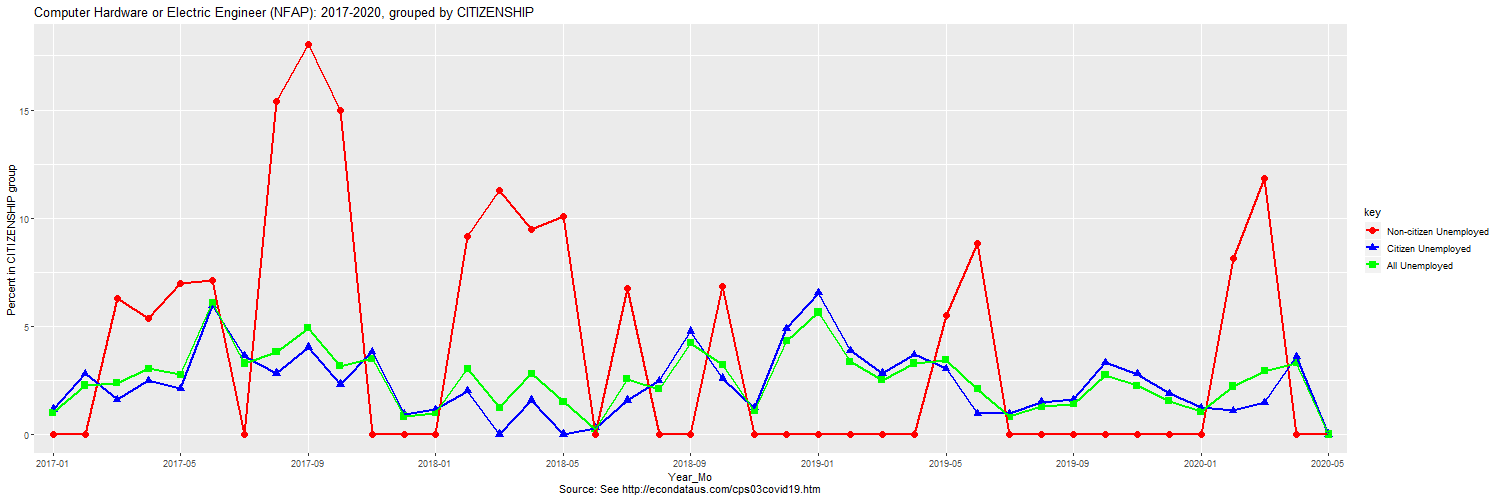
Computer Hardware or Electric Engineer (NFAP): 2017-2020, grouped by CITIZENSHIP year_mo labor_force non_rate cit_rate all_rate non_count cit_count all_count 1 2017-01 410,256.8 0.0 1.2 1.0 0 4,102 4,102 2 2017-02 403,952.2 0.0 2.8 2.3 0 9,150 9,150 3 2017-03 378,590.6 6.3 1.6 2.4 3,884 5,096 8,980 4 2017-04 356,360.1 5.4 2.5 3.0 3,639 7,158 10,797 5 2017-05 382,853.4 7.0 2.1 2.8 3,564 7,018 10,582 6 2017-06 389,183.4 7.1 5.9 6.1 3,703 20,030 23,733 7 2017-07 373,872.6 0.0 3.6 3.3 0 12,265 12,265 8 2017-08 348,857.9 15.4 2.8 3.8 4,228 9,063 13,291 9 2017-09 331,882.1 18.0 4.0 4.9 3,791 12,511 16,302 10 2017-10 370,959.3 15.0 2.3 3.1 3,619 8,051 11,669 11 2017-11 353,286.7 0.0 3.8 3.5 0 12,384 12,384 12 2017-12 424,247.0 0.0 0.9 0.8 0 3,519 3,519 13 2018-01 407,900.9 0.0 1.1 1.0 0 3,973 3,973 14 2018-02 403,846.3 9.2 2.0 3.0 5,355 6,918 12,273 15 2018-03 402,055.9 11.3 0.0 1.2 4,949 0 4,949 16 2018-04 348,383.5 9.5 1.6 2.8 5,159 4,635 9,793 17 2018-05 359,891.9 10.1 0.0 1.5 5,437 0 5,437 18 2018-06 354,240.6 0.0 0.3 0.2 0 861 861 19 2018-07 314,863.1 6.8 1.6 2.6 4,066 4,001 8,067 20 2018-08 275,907.9 0.0 2.5 2.1 0 5,792 5,792 21 2018-09 283,758.9 0.0 4.8 4.2 0 11,980 11,980 22 2018-10 330,312.1 6.9 2.6 3.2 3,382 7,292 10,674 23 2018-11 323,424.9 0.0 1.2 1.1 0 3,489 3,489 24 2018-12 375,043.9 0.0 4.9 4.3 0 16,135 16,135 25 2019-01 375,283.8 0.0 6.5 5.6 0 21,157 21,157 26 2019-02 404,684.6 0.0 3.9 3.4 0 13,578 13,578 27 2019-03 405,971.4 0.0 2.8 2.5 0 10,208 10,208 28 2019-04 381,127.8 0.0 3.7 3.3 0 12,500 12,500 29 2019-05 428,547.5 5.5 3.0 3.4 3,692 11,004 14,696 30 2019-06 369,176.8 8.8 1.0 2.1 4,676 3,037 7,713 31 2019-07 375,490.0 0.0 1.0 0.8 0 3,051 3,051 32 2019-08 366,928.0 0.0 1.5 1.3 0 4,694 4,694 33 2019-09 307,366.5 0.0 1.6 1.4 0 4,322 4,322 34 2019-10 369,911.2 0.0 3.3 2.7 0 10,137 10,137 35 2019-11 364,136.4 0.0 2.8 2.3 0 8,208 8,208 36 2019-12 325,121.5 0.0 1.9 1.5 0 4,996 4,996 37 2020-01 336,924.4 0.0 1.2 1.1 0 3,567 3,567 38 2020-02 375,814.8 8.1 1.1 2.2 4,881 3,462 8,343 39 2020-03 381,110.7 11.8 1.5 2.9 6,343 4,814 11,157 40 2020-04 396,684.7 0.0 3.6 3.3 0 13,059 13,059 41 2020-05 352,812.3 0.0 0.0 0.0 0 0 0
As can be seen, there's nothing that remarkable about these occupations except that they seem to include relatively few non-citizens. One odd thing is that the total number of unemployed went from 13,059 in April to zero in May. This data comes from the Current Population Survey (CPS) and samples just 60,000 eligible households per month. Hence, each survey might represent 2,000 or more workers and this limits the precision of the numbers. Still, this is the only time that the total unemployment has reached zero since at least 2016 so this could merit more investigation. In any event, the following graph and table look only at the category of "Computer Occupations, all other".
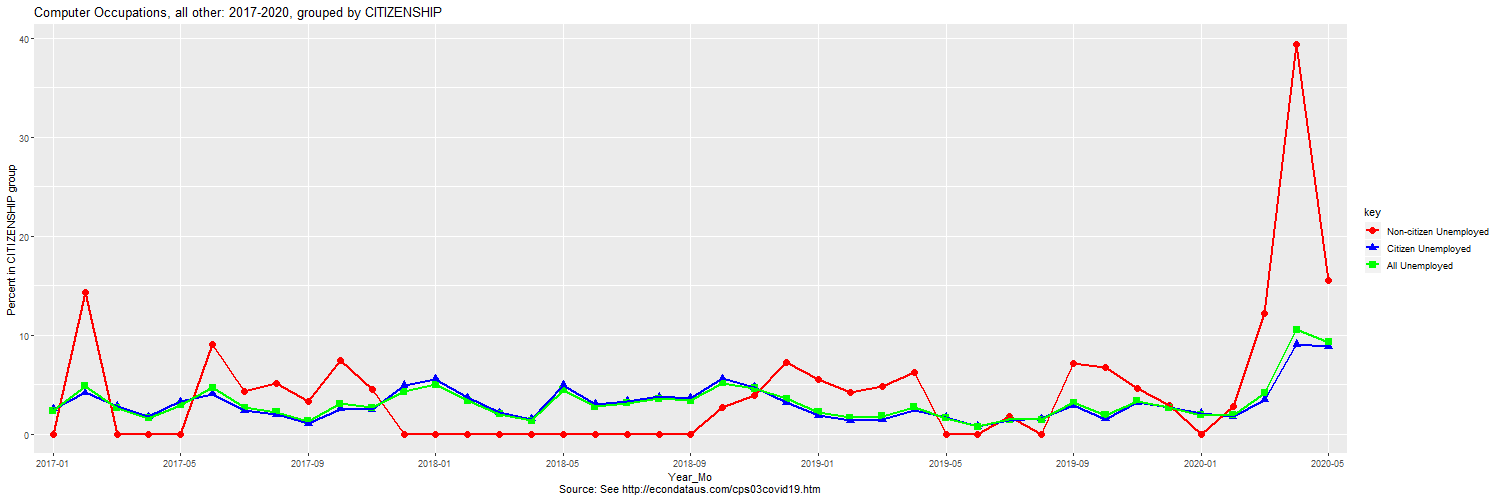
Computer Occupations, all other: 2017-2020, grouped by CITIZENSHIP year_mo labor_force non_rate cit_rate all_rate non_count cit_count all_count 1 2017-01 677,945.8 0.0 2.6 2.4 0 16,348 16,348 2 2017-02 712,520.1 14.3 4.2 4.9 6,914 27,868 34,782 3 2017-03 669,304.8 0.0 2.9 2.6 0 17,661 17,661 4 2017-04 669,229.8 0.0 1.8 1.7 0 11,110 11,110 5 2017-05 631,063.3 0.0 3.3 2.9 0 18,542 18,542 6 2017-06 699,837.5 9.1 4.1 4.7 8,383 24,750 33,132 7 2017-07 683,779.0 4.3 2.4 2.7 4,169 14,118 18,287 8 2017-08 705,217.4 5.1 2.0 2.3 3,331 12,646 15,977 9 2017-09 755,768.2 3.3 1.1 1.3 2,933 7,126 10,060 10 2017-10 730,710.4 7.5 2.6 3.1 5,895 16,651 22,546 11 2017-11 826,743.1 4.6 2.5 2.7 3,578 18,576 22,154 12 2017-12 826,933.2 0.0 5.0 4.3 0 35,727 35,727 13 2018-01 916,218.2 0.0 5.6 5.0 0 46,147 46,147 14 2018-02 761,765.2 0.0 3.7 3.4 0 25,870 25,870 15 2018-03 700,998.6 0.0 2.2 2.0 0 14,340 14,340 16 2018-04 668,857.7 0.0 1.5 1.4 0 9,266 9,266 17 2018-05 676,912.7 0.0 5.0 4.5 0 30,244 30,244 18 2018-06 644,054.9 0.0 3.0 2.8 0 18,076 18,076 19 2018-07 700,532.4 0.0 3.3 3.1 0 21,972 21,972 20 2018-08 733,258.8 0.0 3.8 3.6 0 26,313 26,313 21 2018-09 768,193.6 0.0 3.7 3.4 0 26,024 26,024 22 2018-10 851,425.7 2.8 5.6 5.2 3,653 40,328 43,981 23 2018-11 852,530.7 3.9 4.7 4.6 3,932 35,656 39,588 24 2018-12 871,240.8 7.3 3.2 3.6 5,850 25,607 31,457 25 2019-01 770,163.6 5.6 1.9 2.3 4,018 13,368 17,386 26 2019-02 766,341.9 4.2 1.4 1.7 3,748 9,267 13,015 27 2019-03 697,420.9 4.8 1.5 1.9 3,452 9,524 12,976 28 2019-04 747,473.6 6.2 2.5 2.7 3,404 16,997 20,401 29 2019-05 741,401.5 0.0 1.7 1.6 0 12,025 12,025 30 2019-06 802,313.8 0.0 0.8 0.8 0 6,154 6,154 31 2019-07 906,945.2 1.8 1.5 1.5 791 12,594 13,385 32 2019-08 941,302.6 0.0 1.6 1.5 0 13,969 13,969 33 2019-09 890,826.3 7.2 2.9 3.2 4,177 24,517 28,695 34 2019-10 888,725.5 6.8 1.6 1.9 4,148 12,872 17,021 35 2019-11 872,928.0 4.7 3.2 3.3 3,935 25,193 29,128 36 2019-12 907,133.2 2.9 2.7 2.7 2,881 21,578 24,459 37 2020-01 951,611.7 0.0 2.1 2.0 0 18,671 18,671 38 2020-02 952,499.8 2.9 1.8 1.9 3,038 15,266 18,304 39 2020-03 825,703.9 12.2 3.5 4.2 7,789 26,508 34,297 40 2020-04 908,764.6 39.4 9.1 10.6 17,088 78,803 95,891 41 2020-05 827,213.0 15.5 8.8 9.3 8,711 68,206 76,917
As can be seen, the unemployment rate of non-citizen workers in this category spiked in April to 39.4 percent but fell to 15.5 percent in May. On the other hand, the unemployment rate of citizen workers in this category grew from 3.5 percent to 9.1 percent in April and has recovered only slightly, to 8.8 percent. This seems to have been the category of computer occupations hit hardest by the COVID-19 crisis and represents the best argument for holding off on any additional non-citizen immigration for computer jobs. Perhaps not coincidentally, this was the category of computer occupation that was excluded in the NFAP analysis. This would seem an additional reason for media to require that such analyses include the means to reproduce them. That would likely have allowed these problems to be found much sooner.
Forbes Posts Another Stuart Anderson Editorial with the Same Numbers
On June 23, 2020, Forbes Magazine posted an article by Stuart Anderson titled New Trump H-1B Visa Restrictions Will Harm Companies. As the title suggests, it is in response to the new proclamation from Trump to restrict certain temporary visas. It repeats a claim in his prior editorial, stating:
The unemployment rate for individuals in computer occupations declined from 3% in January 2020 (before the pandemic spread in the U.S.) to 2.8% in April 2020, and fell again to 2.5% in May 2020, according to an analysis of the Bureau of Labor Statistics' Current Population Survey by the National Foundation for American Policy (NFAP). The unemployment rate in computer occupations has been stable and, in fact, falling. The vast majority of H-1B visa holders work in computer occupations.
Unlike the prior editorial, this one no longer mentions the lower unemployment rates of 2.4% and 1.9% in February and March, respectively. It appears that this provided too much context for the readers to handle. In any case, the problems with Stuart Anderson's numbers are summarized in the final section below.
Washington Post Posts an Editorial Quoting Stuart Anderson's 2.5 Number for May
On June 29, 2020, the Washington Post posted an editorial by their columnist, Catherine Rampell, titled Trump's visa suspensions may permanently damage America's reputation. The editorial references a Forbes editorial in the following statement:
While unemployment overall is in double digits, in his field - computer-related occupations - unemployment has declined since the pandemic began, hitting 2.5 percent in May.
On June 29th, I wrote the Washington Post corrections department at corrections@washpost.com to report this error but I have received no response. On July 2nd, Ron Hira, a professor at Howard University, tweeted about the same problem to the Washington Post, Catherine Rampell, and Glenn Kessler, the chief writer of Washington Post's Fact Checker. He included a graph of the BLS series LNU04034021 whose series title is "(Unadj) Unemployment Rate - Computer and Mathematical Occupation". It shows that the unemployment rate for these occupations was 3.7% in May & 4.3% in June. It's possible to see both the 3.7 number for May and the 4.3 number for June on the BLS website. It's also possible to generate a graph and table of the series by going to this page on the BLS website, typing in the series id LNU04034021, clicking Next, change the year range if desired, check the "include graphs" checkbox, and click "Retrieve Data". Following is the resultant graph and table when specifying the starting year as 2013:
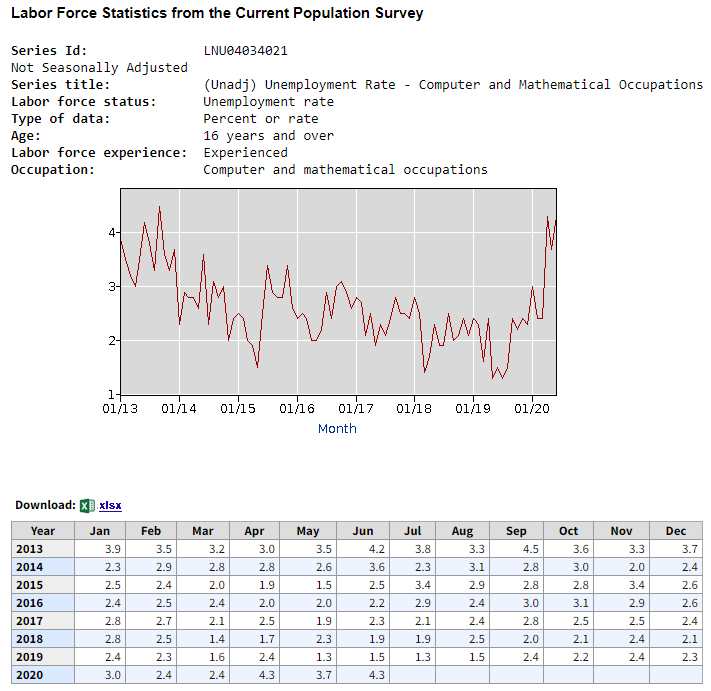
As can be seen, the unemployment rate for Computer and Mathematical occupations reached 4.3 percent in June, its highest level since September of 2013, during its recovery from the financial crisis.
Unemployment Rate for Computer Occupations Soars in June, Even By Stuart Anderson's Definition
On July 9, 2020, the Basic Monthly CPS data for June became available on the Census website. The following graph and table shows the updated results using Stuart Anderson's questionable definition of computer occupations.
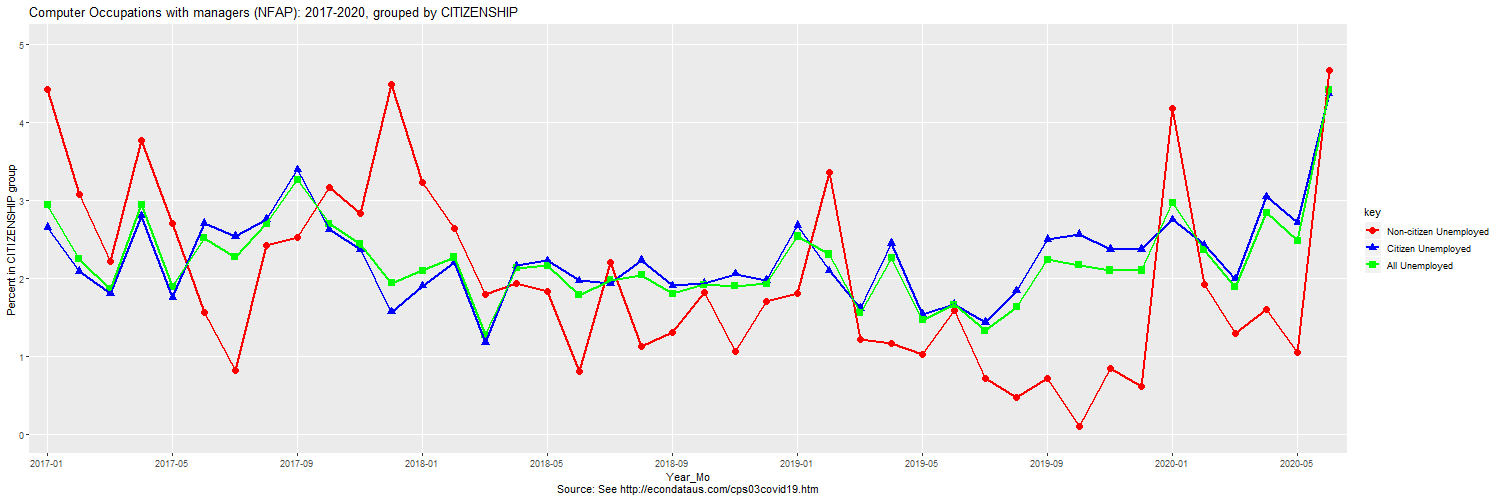
Computer Occupations with managers (NFAP): 2017-2020, grouped by CITIZENSHIP year_mo labor_force non_rate cit_rate all_rate non_count cit_count all_count 1 2017-01 5,083,329 4.4 2.7 2.9 35,608 113,686 149,294 2 2017-02 5,007,023 3.1 2.1 2.2 24,350 88,110 112,460 3 2017-03 4,921,265 2.2 1.8 1.9 16,225 75,456 91,681 4 2017-04 4,983,520 3.8 2.8 2.9 27,594 119,085 146,679 5 2017-05 4,887,519 2.7 1.7 1.9 19,922 72,621 92,543 6 2017-06 4,871,279 1.6 2.7 2.5 12,476 110,183 122,659 7 2017-07 4,777,019 0.8 2.5 2.3 6,121 102,340 108,461 8 2017-08 4,887,736 2.4 2.8 2.7 19,337 112,815 132,153 9 2017-09 4,941,581 2.5 3.4 3.3 19,055 142,162 161,217 10 2017-10 4,973,484 3.2 2.6 2.7 21,667 112,810 134,477 11 2017-11 5,097,665 2.8 2.4 2.4 20,012 104,162 124,173 12 2017-12 5,168,565 4.5 1.6 1.9 29,454 70,786 100,240 13 2018-01 5,204,071 3.2 1.9 2.1 24,481 84,624 109,104 14 2018-02 5,386,050 2.6 2.2 2.3 21,772 100,409 122,182 15 2018-03 5,341,738 1.8 1.2 1.3 15,174 52,967 68,141 16 2018-04 5,187,960 1.9 2.2 2.1 15,372 95,131 110,503 17 2018-05 5,241,516 1.8 2.2 2.2 15,664 97,719 113,383 18 2018-06 5,144,426 0.8 2.0 1.8 6,414 85,569 91,983 19 2018-07 5,142,346 2.2 1.9 2.0 18,644 83,032 101,676 20 2018-08 5,156,508 1.1 2.2 2.0 10,035 95,221 105,256 21 2018-09 5,004,165 1.3 1.9 1.8 10,777 79,570 90,347 22 2018-10 5,169,572 1.8 1.9 1.9 14,532 84,735 99,267 23 2018-11 5,186,986 1.1 2.1 1.9 8,745 89,765 98,510 24 2018-12 5,234,781 1.7 2.0 1.9 14,178 86,988 101,166 25 2019-01 5,154,654 1.8 2.7 2.5 15,205 115,648 130,854 26 2019-02 5,429,520 3.4 2.1 2.3 30,370 94,890 125,260 27 2019-03 5,271,519 1.2 1.6 1.6 10,295 71,602 81,897 28 2019-04 5,221,387 1.2 2.4 2.3 9,135 108,711 117,846 29 2019-05 5,413,793 1.0 1.5 1.5 7,897 71,472 79,369 30 2019-06 5,406,565 1.6 1.7 1.7 13,725 76,018 89,743 31 2019-07 5,533,182 0.7 1.4 1.3 6,052 67,442 73,495 32 2019-08 5,630,362 0.5 1.8 1.6 4,024 87,974 91,998 33 2019-09 5,410,845 0.7 2.5 2.2 5,701 115,425 121,126 34 2019-10 5,311,873 0.1 2.6 2.2 828 114,536 115,363 35 2019-11 5,301,418 0.8 2.4 2.1 7,978 103,430 111,408 36 2019-12 5,269,303 0.6 2.4 2.1 5,037 105,728 110,765 37 2020-01 5,540,113 4.2 2.8 3.0 35,387 129,266 164,653 38 2020-02 5,602,755 1.9 2.4 2.4 14,942 117,460 132,402 39 2020-03 5,794,298 1.3 2.0 1.9 11,458 97,810 109,268 40 2020-04 5,955,976 1.6 3.1 2.8 13,588 155,760 169,348 41 2020-05 6,030,322 1.0 2.7 2.5 8,921 140,820 149,741 42 2020-06 6,310,136 4.7 4.4 4.4 44,361 234,111 278,472As can be seen, even Anderson's questionable definition shows the unemployment rate of computer occupations soaring almost 2 percent, from 2.5 percent in May to 4.4 percent in June. As described in the Summary section below, an arguably better model includes the "Computer Occupations, all other" category and excludes the "Computer and information systems manager" category. The following graph and table show the results for that definition.
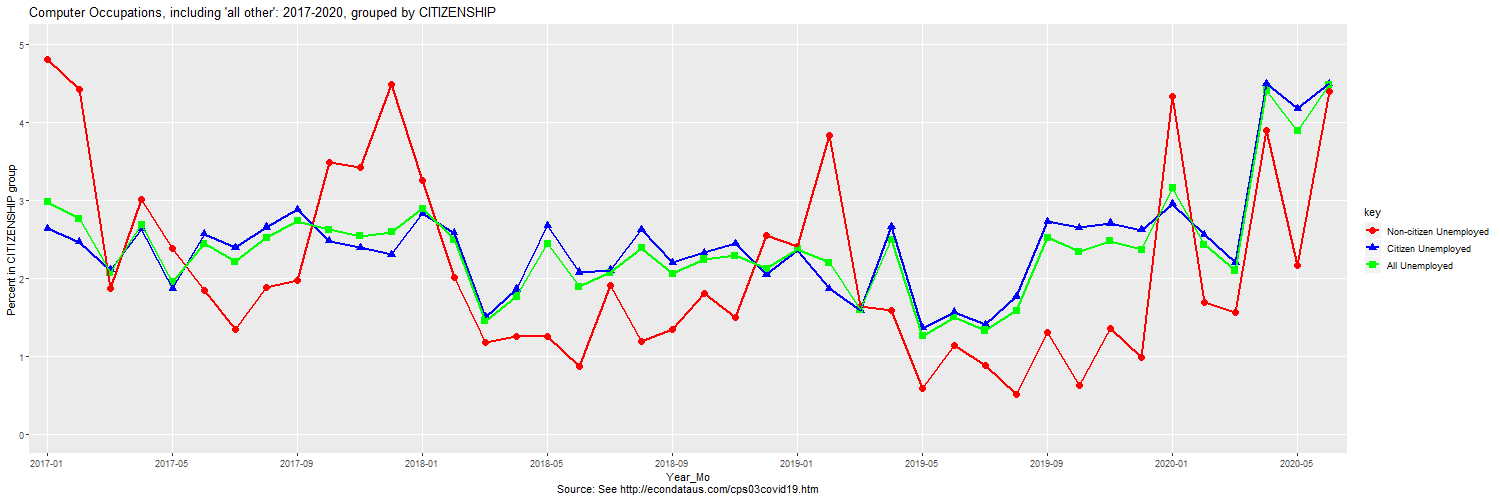
Computer Occupations, including 'all other': 2017-2020, grouped by CITIZENSHIP year_mo labor_force non_rate cit_rate all_rate non_count cit_count all_count 1 2017-01 4,685,816 4.8 2.6 3.0 35,608 103,944 139,552 2 2017-02 4,631,068 4.4 2.5 2.8 31,264 96,769 128,032 3 2017-03 4,498,666 1.9 2.1 2.1 12,341 80,915 93,256 4 2017-04 4,634,233 3.0 2.6 2.7 19,728 104,781 124,508 5 2017-05 4,498,814 2.4 1.9 2.0 16,358 71,373 87,731 6 2017-06 4,598,185 1.8 2.6 2.4 14,447 98,025 112,472 7 2017-07 4,512,675 1.3 2.4 2.2 10,290 89,706 99,996 8 2017-08 4,623,816 1.9 2.7 2.5 14,694 101,987 116,681 9 2017-09 4,716,498 2.0 2.9 2.7 15,191 113,710 128,901 10 2017-10 4,672,188 3.5 2.5 2.6 23,943 98,765 122,708 11 2017-11 4,917,446 3.4 2.4 2.5 23,590 101,252 124,842 12 2017-12 4,909,810 4.5 2.3 2.6 29,454 97,973 127,427 13 2018-01 5,091,390 3.3 2.8 2.9 23,571 123,616 147,187 14 2018-02 5,123,750 2.0 2.6 2.5 15,408 112,427 127,835 15 2018-03 5,049,461 1.2 1.5 1.5 9,243 64,204 73,447 16 2018-04 4,897,968 1.3 1.9 1.8 9,279 77,374 86,653 17 2018-05 4,944,899 1.3 2.7 2.4 10,227 110,594 120,821 18 2018-06 4,795,027 0.9 2.1 1.9 6,414 84,368 90,782 19 2018-07 4,891,323 1.9 2.1 2.1 14,578 86,841 101,420 20 2018-08 4,997,171 1.2 2.6 2.4 10,035 109,150 119,185 21 2018-09 4,866,778 1.3 2.2 2.1 10,777 89,525 100,303 22 2018-10 4,995,703 1.8 2.3 2.2 14,803 97,273 112,077 23 2018-11 5,055,289 1.5 2.4 2.3 12,677 103,087 115,764 24 2018-12 5,029,231 2.6 2.0 2.1 20,028 86,884 106,913 25 2019-01 4,947,938 2.4 2.4 2.4 19,223 98,116 117,339 26 2019-02 5,157,313 3.8 1.9 2.2 33,523 79,948 113,471 27 2019-03 4,965,726 1.6 1.6 1.6 13,177 66,263 79,440 28 2019-04 4,955,578 1.6 2.7 2.5 11,893 111,920 123,813 29 2019-05 5,061,264 0.6 1.4 1.3 4,205 59,402 63,607 30 2019-06 5,209,893 1.1 1.6 1.5 9,049 69,116 78,165 31 2019-07 5,386,494 0.9 1.4 1.3 6,843 64,925 71,768 32 2019-08 5,439,314 0.5 1.8 1.6 4,024 82,135 86,160 33 2019-09 5,279,188 1.3 2.7 2.5 9,879 123,347 133,225 34 2019-10 5,153,748 0.6 2.6 2.3 4,976 115,596 120,573 35 2019-11 5,142,270 1.4 2.7 2.5 11,913 115,492 127,405 36 2019-12 5,147,469 1.0 2.6 2.4 7,918 113,941 121,859 37 2020-01 5,476,662 4.3 3.0 3.2 35,387 137,614 173,001 38 2020-02 5,450,395 1.7 2.6 2.4 13,098 119,534 132,633 39 2020-03 5,421,957 1.6 2.2 2.1 12,903 101,111 114,014 40 2020-04 5,644,330 3.9 4.5 4.4 30,676 218,265 248,940 41 2020-05 5,682,895 2.2 4.2 3.9 17,633 203,287 220,920 42 2020-06 5,892,368 4.4 4.5 4.5 38,611 225,547 264,158As can be seen, this better definition shows a nearly identical unemployment rate of 4.5 percent for June. It is unclear exactly why the two definitions are now in agreement. It may be some combination of the unemployment rate of managers starting to increase and the unemployment rate of the "All Other" category becoming closer to that of other computer occupations. In any event, both definitions now show the unemployment rate of U.S. workers in computer occupations to be at their highest level since at least January of 2017. It will be interesting to see if Stuart Anderson releases an update of his numbers and admit that the numbers now show that the unemployment rate of computer occupations is very much increasing, not decreasing as he stated in his prior editorials. More likely, he will just move on to other topics.
Note: The above two graphs and tables can be reproduced with the program in this section by changing line 40 from "maxmnth <- 5" to "maxmnth <- 6". In addition, the first graph and table are generated by uncommenting just the occt assignment on line 49, occt <- "Computer Occupations with managers (NFAP)". The second graph and table are generated by uncommenting just the occt assignment on line 45, occt <- "Computer Occupations, including 'all other'".
Unemployment Rate for Computer and Mathematical Occupations Continues to Rise in July
On August 7, 2020, The Bureau of Labor Statistics released the Employment Situation report for July 2020. The report begins:
Total nonfarm payroll employment rose by 1.8 million in July, and the unemployment rate fell to 10.2 percent, the U.S. Bureau of Labor Statistics reported today. These improvements in the labor market reflected the continued resumption of economic activity that had been curtailed due to the coronavirus (COVID-19) pandemic and efforts to contain it. In July, notable job gains occurred in leisure and hospitality, government, retail trade, professional and business services, other services, and health care.
It's possible to look at the unemployment rate for Computer and Mathematical Occupations by going to this page on the BLS website, typing in the series id LNU04034021, clicking Next, change the year range if desired, check the "include graphs" checkbox, and click "Retrieve Data". Following is the resultant graph and table when specifying the starting year as 2013:
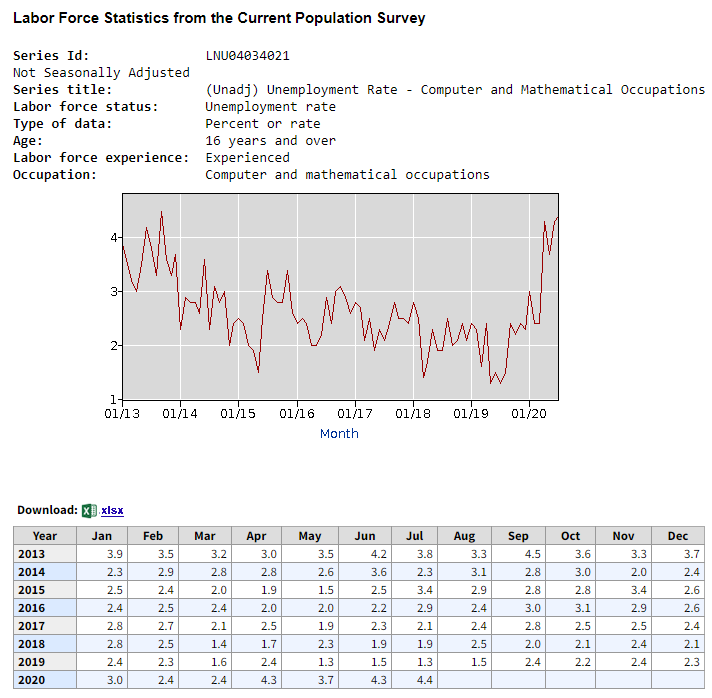
As can be seen, the unemployment rate for Computer and Mathematical occupations rose slightly to 4.4 percent in July, its highest level since September of 2013, during its recovery from the financial crisis.
Unemployment Rate for Computer and Mathematical Occupations Continues to Rise in August
On September 4, 2020, The Bureau of Labor Statistics released the Employment Situation report for August 2020. The report begins:
Total nonfarm payroll employment rose by 1.4 million in August, and the unemployment rate fell to 8.4 percent, the U.S. Bureau of Labor Statistics reported today. These improvements in the labor market reflect the continued resumption of economic activity that had been curtailed due to the coronavirus (COVID-19) pandemic and efforts to contain it. In August, an increase in government employment largely reflected temporary hiring for the 2020 Census. Notable job gains also occurred in retail trade, in professional and business services, in leisure and hospitality, and in education and health services.
It's possible to look at the unemployment rate for Computer and Mathematical Occupations by going to this page on the BLS website, typing in the series id LNU04034021, clicking Next, change the year range if desired, check the "include graphs" checkbox, and click "Retrieve Data". Following is the resultant graph and table when specifying the starting year as 2012:
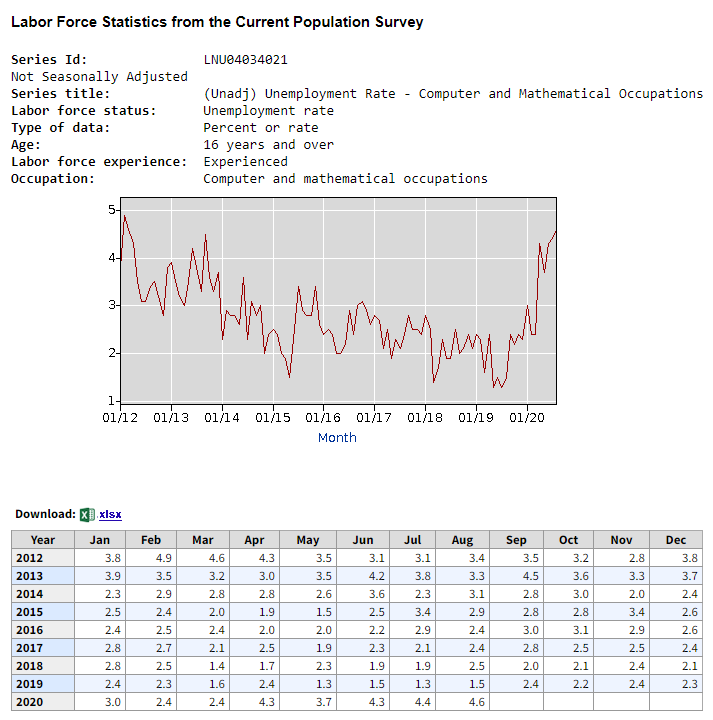
As can be seen, the unemployment rate for Computer and Mathematical occupations rose to 4.6 in August, its highest level since February of 2012, during its recovery from the financial crisis.
On September 9, 2020, the Basic Monthly CPS data for August became available on the Census website. The following graph and table shows the updated results using Stuart Anderson's questionable definition of computer occupations.

Computer Occupations with managers (NFAP): 2017-2020, grouped by CITIZENSHIP year_mo labor_force non_rate cit_rate all_rate non_count cit_count all_count 1 2017-01 5,083,329 4.4 2.7 2.9 35,608 113,686 149,294 2 2017-02 5,007,023 3.1 2.1 2.2 24,350 88,110 112,460 3 2017-03 4,921,265 2.2 1.8 1.9 16,225 75,456 91,681 4 2017-04 4,983,520 3.8 2.8 2.9 27,594 119,085 146,679 5 2017-05 4,887,519 2.7 1.7 1.9 19,922 72,621 92,543 6 2017-06 4,871,279 1.6 2.7 2.5 12,476 110,183 122,659 7 2017-07 4,777,019 0.8 2.5 2.3 6,121 102,340 108,461 8 2017-08 4,887,736 2.4 2.8 2.7 19,337 112,815 132,153 9 2017-09 4,941,581 2.5 3.4 3.3 19,055 142,162 161,217 10 2017-10 4,973,484 3.2 2.6 2.7 21,667 112,810 134,477 11 2017-11 5,097,665 2.8 2.4 2.4 20,012 104,162 124,173 12 2017-12 5,168,565 4.5 1.6 1.9 29,454 70,786 100,240 13 2018-01 5,204,071 3.2 1.9 2.1 24,481 84,624 109,104 14 2018-02 5,386,050 2.6 2.2 2.3 21,772 100,409 122,182 15 2018-03 5,341,738 1.8 1.2 1.3 15,174 52,967 68,141 16 2018-04 5,187,960 1.9 2.2 2.1 15,372 95,131 110,503 17 2018-05 5,241,516 1.8 2.2 2.2 15,664 97,719 113,383 18 2018-06 5,144,426 0.8 2.0 1.8 6,414 85,569 91,983 19 2018-07 5,142,346 2.2 1.9 2.0 18,644 83,032 101,676 20 2018-08 5,156,508 1.1 2.2 2.0 10,035 95,221 105,256 21 2018-09 5,004,165 1.3 1.9 1.8 10,777 79,570 90,347 22 2018-10 5,169,572 1.8 1.9 1.9 14,532 84,735 99,267 23 2018-11 5,186,986 1.1 2.1 1.9 8,745 89,765 98,510 24 2018-12 5,234,781 1.7 2.0 1.9 14,178 86,988 101,166 25 2019-01 5,154,654 1.8 2.7 2.5 15,205 115,648 130,854 26 2019-02 5,429,520 3.4 2.1 2.3 30,370 94,890 125,260 27 2019-03 5,271,519 1.2 1.6 1.6 10,295 71,602 81,897 28 2019-04 5,221,387 1.2 2.4 2.3 9,135 108,711 117,846 29 2019-05 5,413,793 1.0 1.5 1.5 7,897 71,472 79,369 30 2019-06 5,406,565 1.6 1.7 1.7 13,725 76,018 89,743 31 2019-07 5,533,182 0.7 1.4 1.3 6,052 67,442 73,495 32 2019-08 5,630,362 0.5 1.8 1.6 4,024 87,974 91,998 33 2019-09 5,410,845 0.7 2.5 2.2 5,701 115,425 121,126 34 2019-10 5,311,873 0.1 2.6 2.2 828 114,536 115,363 35 2019-11 5,301,418 0.8 2.4 2.1 7,978 103,430 111,408 36 2019-12 5,269,303 0.6 2.4 2.1 5,037 105,728 110,765 37 2020-01 5,540,113 4.2 2.8 3.0 35,387 129,266 164,653 38 2020-02 5,602,755 1.9 2.4 2.4 14,942 117,460 132,402 39 2020-03 5,794,298 1.3 2.0 1.9 11,458 97,810 109,268 40 2020-04 5,955,976 1.6 3.1 2.8 13,588 155,760 169,348 41 2020-05 6,030,322 1.0 2.7 2.5 8,921 140,820 149,741 42 2020-06 6,310,136 4.7 4.4 4.4 44,361 234,111 278,472 43 2020-07 6,044,541 3.7 3.9 3.9 29,628 206,333 235,961 44 2020-08 5,875,240 1.0 5.0 4.5 8,277 253,568 261,845As can be seen, even Anderson's questionable definition shows the unemployment rate of computer occupations soaring 2 percent, from 2.5 percent in May to 4.5 percent in August. Looking just at computer occupations held by U.S. citizens, the unemployment rate rose from 2.7 percent in May to 5.0 percent in August. As described in the Summary section below, an arguably better model includes the "Computer Occupations, all other" category and excludes the "Computer and information systems manager" category. The following graph and table show the results for that definition.

Computer Occupations, including 'all other': 2017-2020, grouped by CITIZENSHIP year_mo labor_force non_rate cit_rate all_rate non_count cit_count all_count 1 2017-01 4,685,816 4.8 2.6 3.0 35,608 103,944 139,552 2 2017-02 4,631,068 4.4 2.5 2.8 31,264 96,769 128,032 3 2017-03 4,498,666 1.9 2.1 2.1 12,341 80,915 93,256 4 2017-04 4,634,233 3.0 2.6 2.7 19,728 104,781 124,508 5 2017-05 4,498,814 2.4 1.9 2.0 16,358 71,373 87,731 6 2017-06 4,598,185 1.8 2.6 2.4 14,447 98,025 112,472 7 2017-07 4,512,675 1.3 2.4 2.2 10,290 89,706 99,996 8 2017-08 4,623,816 1.9 2.7 2.5 14,694 101,987 116,681 9 2017-09 4,716,498 2.0 2.9 2.7 15,191 113,710 128,901 10 2017-10 4,672,188 3.5 2.5 2.6 23,943 98,765 122,708 11 2017-11 4,917,446 3.4 2.4 2.5 23,590 101,252 124,842 12 2017-12 4,909,810 4.5 2.3 2.6 29,454 97,973 127,427 13 2018-01 5,091,390 3.3 2.8 2.9 23,571 123,616 147,187 14 2018-02 5,123,750 2.0 2.6 2.5 15,408 112,427 127,835 15 2018-03 5,049,461 1.2 1.5 1.5 9,243 64,204 73,447 16 2018-04 4,897,968 1.3 1.9 1.8 9,279 77,374 86,653 17 2018-05 4,944,899 1.3 2.7 2.4 10,227 110,594 120,821 18 2018-06 4,795,027 0.9 2.1 1.9 6,414 84,368 90,782 19 2018-07 4,891,323 1.9 2.1 2.1 14,578 86,841 101,420 20 2018-08 4,997,171 1.2 2.6 2.4 10,035 109,150 119,185 21 2018-09 4,866,778 1.3 2.2 2.1 10,777 89,525 100,303 22 2018-10 4,995,703 1.8 2.3 2.2 14,803 97,273 112,077 23 2018-11 5,055,289 1.5 2.4 2.3 12,677 103,087 115,764 24 2018-12 5,029,231 2.6 2.0 2.1 20,028 86,884 106,913 25 2019-01 4,947,938 2.4 2.4 2.4 19,223 98,116 117,339 26 2019-02 5,157,313 3.8 1.9 2.2 33,523 79,948 113,471 27 2019-03 4,965,726 1.6 1.6 1.6 13,177 66,263 79,440 28 2019-04 4,955,578 1.6 2.7 2.5 11,893 111,920 123,813 29 2019-05 5,061,264 0.6 1.4 1.3 4,205 59,402 63,607 30 2019-06 5,209,893 1.1 1.6 1.5 9,049 69,116 78,165 31 2019-07 5,386,494 0.9 1.4 1.3 6,843 64,925 71,768 32 2019-08 5,439,314 0.5 1.8 1.6 4,024 82,135 86,160 33 2019-09 5,279,188 1.3 2.7 2.5 9,879 123,347 133,225 34 2019-10 5,153,748 0.6 2.6 2.3 4,976 115,596 120,573 35 2019-11 5,142,270 1.4 2.7 2.5 11,913 115,492 127,405 36 2019-12 5,147,469 1.0 2.6 2.4 7,918 113,941 121,859 37 2020-01 5,476,662 4.3 3.0 3.2 35,387 137,614 173,001 38 2020-02 5,450,395 1.7 2.6 2.4 13,098 119,534 132,633 39 2020-03 5,421,957 1.6 2.2 2.1 12,903 101,111 114,014 40 2020-04 5,644,330 3.9 4.5 4.4 30,676 218,265 248,940 41 2020-05 5,682,895 2.2 4.2 3.9 17,633 203,287 220,920 42 2020-06 5,892,368 4.4 4.5 4.5 38,611 225,547 264,158 43 2020-07 5,807,555 4.0 4.7 4.6 29,463 239,978 269,441 44 2020-08 5,465,255 1.1 5.3 4.8 8,277 251,624 259,901As can be seen, this better definition shows an even higher unemployment rate of 4.8 percent for August for all workers in computer occupations and 5.3 percent for those who are U.S. citizens. Both definitions now show the unemployment rate of U.S. workers in computer occupations to be at their highest level since at least January of 2017. As before, it will be interesting to see if Stuart Anderson releases an update of his numbers and admit that the numbers now show that the unemployment rate of computer occupations is very much increasing, not decreasing as he stated in his prior editorials. Judging from the past several months since May, he will just continue to focus on other topics.
Note: The above two graphs and tables can be reproduced with the program in this section by changing line 40 from "maxmnth <- 5" to "maxmnth <- 8". In addition, the first graph and table are generated by uncommenting just the occt assignment on line 49, occt <- "Computer Occupations with managers (NFAP)". The second graph and table are generated by uncommenting just the occt assignment on line 45, occt <- "Computer Occupations, including 'all other'" and increasing ymax to 5.3 in order to display the new high level of unemployment.
On October 13, 2020, Forbes Magazine posted an article by Stuart Anderson titled Tech Employment Data Contradict Need For Quick H-1B Visa Rules. As the title suggests, it is in response to new H-1B visa restrictions put out by the Trump administration. It begins:
New government data show the low unemployment rate in computer occupations contradicts Trump administration claims an economic emergency requires the quick implementation of new H-1B visa rules. A new analysis indicates the government's own data do not support the claims made in the regulations, which makes it more likely federal courts will block the new rules.
Further on, it states:
"The U.S. unemployment rate for individuals in computer occupations stood at 3.5% in September 2020, not changed significantly from the 3% unemployment rate in January 2020 (before the pandemic spread in the U.S.)," according to an analysis of the Bureau of Labor Statistics' Current Population Survey by the National Foundation for American Policy (NFAP). "A similar measure of the U.S. unemployment rate in computer and mathematical occupations, which appears on the BLS website, also found a rate of 3% in January 2020 and 3.5% in September 2020. The rates are well below the unemployment rate of 7.8% for non-computer occupations."
On October 12, 2020, the Basic Monthly CPS data for September became available on the Census website. The following graph and table shows the updated results using Stuart Anderson's questionable definition of computer occupations.
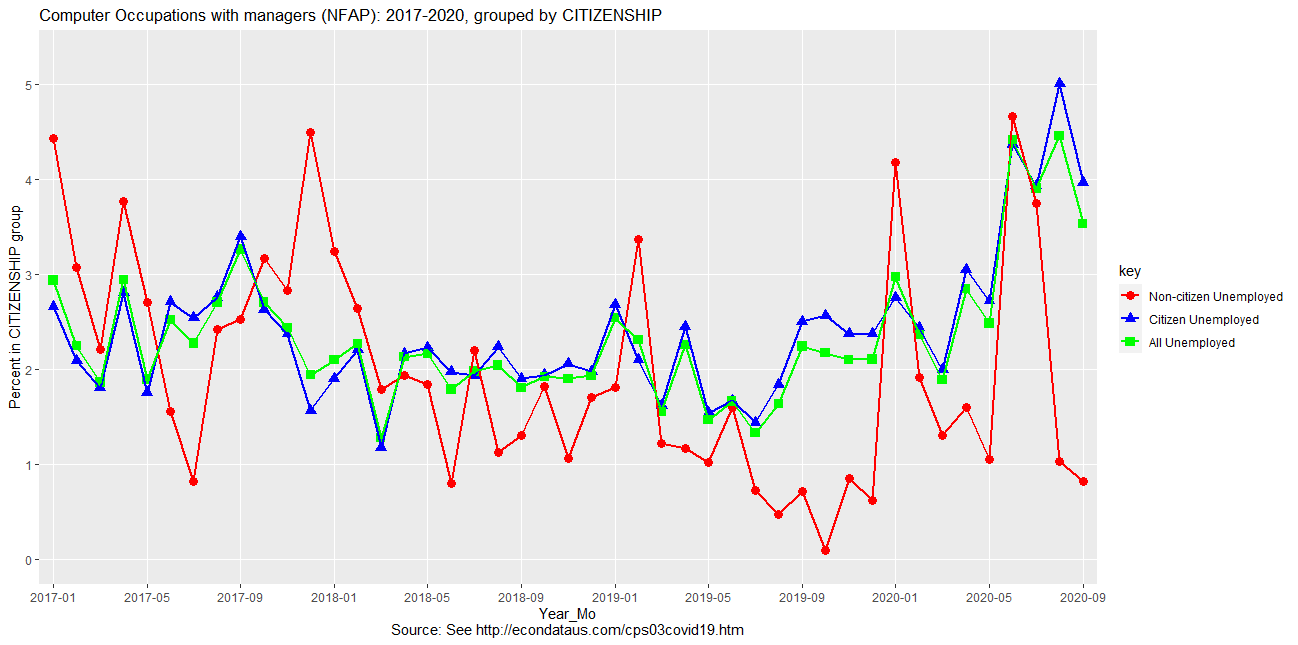
Computer Occupations with managers (NFAP): 2017-2020, grouped by CITIZENSHIP year_mo labor_force non_rate cit_rate all_rate non_count cit_count all_count 1 2017-01 5,083,329 4.4 2.7 2.9 35,608 113,686 149,294 2 2017-02 5,007,023 3.1 2.1 2.2 24,350 88,110 112,460 3 2017-03 4,921,265 2.2 1.8 1.9 16,225 75,456 91,681 4 2017-04 4,983,520 3.8 2.8 2.9 27,594 119,085 146,679 5 2017-05 4,887,519 2.7 1.7 1.9 19,922 72,621 92,543 6 2017-06 4,871,279 1.6 2.7 2.5 12,476 110,183 122,659 7 2017-07 4,777,019 0.8 2.5 2.3 6,121 102,340 108,461 8 2017-08 4,887,736 2.4 2.8 2.7 19,337 112,815 132,153 9 2017-09 4,941,581 2.5 3.4 3.3 19,055 142,162 161,217 10 2017-10 4,973,484 3.2 2.6 2.7 21,667 112,810 134,477 11 2017-11 5,097,665 2.8 2.4 2.4 20,012 104,162 124,173 12 2017-12 5,168,565 4.5 1.6 1.9 29,454 70,786 100,240 13 2018-01 5,204,071 3.2 1.9 2.1 24,481 84,624 109,104 14 2018-02 5,386,050 2.6 2.2 2.3 21,772 100,409 122,182 15 2018-03 5,341,738 1.8 1.2 1.3 15,174 52,967 68,141 16 2018-04 5,187,960 1.9 2.2 2.1 15,372 95,131 110,503 17 2018-05 5,241,516 1.8 2.2 2.2 15,664 97,719 113,383 18 2018-06 5,144,426 0.8 2.0 1.8 6,414 85,569 91,983 19 2018-07 5,142,346 2.2 1.9 2.0 18,644 83,032 101,676 20 2018-08 5,156,508 1.1 2.2 2.0 10,035 95,221 105,256 21 2018-09 5,004,165 1.3 1.9 1.8 10,777 79,570 90,347 22 2018-10 5,169,572 1.8 1.9 1.9 14,532 84,735 99,267 23 2018-11 5,186,986 1.1 2.1 1.9 8,745 89,765 98,510 24 2018-12 5,234,781 1.7 2.0 1.9 14,178 86,988 101,166 25 2019-01 5,154,654 1.8 2.7 2.5 15,205 115,648 130,854 26 2019-02 5,429,520 3.4 2.1 2.3 30,370 94,890 125,260 27 2019-03 5,271,519 1.2 1.6 1.6 10,295 71,602 81,897 28 2019-04 5,221,387 1.2 2.4 2.3 9,135 108,711 117,846 29 2019-05 5,413,793 1.0 1.5 1.5 7,897 71,472 79,369 30 2019-06 5,406,565 1.6 1.7 1.7 13,725 76,018 89,743 31 2019-07 5,533,182 0.7 1.4 1.3 6,052 67,442 73,495 32 2019-08 5,630,362 0.5 1.8 1.6 4,024 87,974 91,998 33 2019-09 5,410,845 0.7 2.5 2.2 5,701 115,425 121,126 34 2019-10 5,311,873 0.1 2.6 2.2 828 114,536 115,363 35 2019-11 5,301,418 0.8 2.4 2.1 7,978 103,430 111,408 36 2019-12 5,269,303 0.6 2.4 2.1 5,037 105,728 110,765 37 2020-01 5,540,113 4.2 2.8 3.0 35,387 129,266 164,653 38 2020-02 5,602,755 1.9 2.4 2.4 14,942 117,460 132,402 39 2020-03 5,794,298 1.3 2.0 1.9 11,458 97,810 109,268 40 2020-04 5,955,976 1.6 3.1 2.8 13,588 155,760 169,348 41 2020-05 6,030,322 1.0 2.7 2.5 8,921 140,820 149,741 42 2020-06 6,310,136 4.7 4.4 4.4 44,361 234,111 278,472 43 2020-07 6,044,541 3.7 3.9 3.9 29,628 206,333 235,961 44 2020-08 5,875,240 1.0 5.0 4.5 8,277 253,568 261,845 45 2020-09 5,367,953 0.8 4.0 3.5 6,063 183,429 189,492As can be seen, Anderson's questionable definition shows the unemployment rate of computer occupations rose from 3.0 percent in January to 3.5 percent in September, a rise of just 0.5 percent as mentioned in the Forbes article. Looking just at computer occupations held by U.S. citizens, however, the unemployment rate rose from 2.8 percent in January to 4.0 percent in September, a much larger rise of 1.2 percent. Hence, the 0.5 percent rise in total unemployment since January is composed of a 1.2 percent rise in the unemployment of U.S. citizens and 3.4 percent drop in unemployment of non-citizens. It is the unemployment of U.S. citizens that is the concern of the new H-1B visa restrictions so the 1.2 percent rise in their unemployment is the concern. Also, the unemployment rate does not necessarily tell the entire story. Now that the pandemic has continued for over 6 months, it is possible that the unemployment benefits of some U.S. citizens in computer occupations has run out. They may have been forced to take lower paying jobs in other industries to maintain an income. This problem with looking at the unemployment rate of a specific industry is discussed in red font in the Summary section below. That section also describes how an arguably better definition of computer occupations includes the "Computer Occupations, all other" category and excludes the "Computer and information systems manager" category. The following graph and table show the results for that definition.
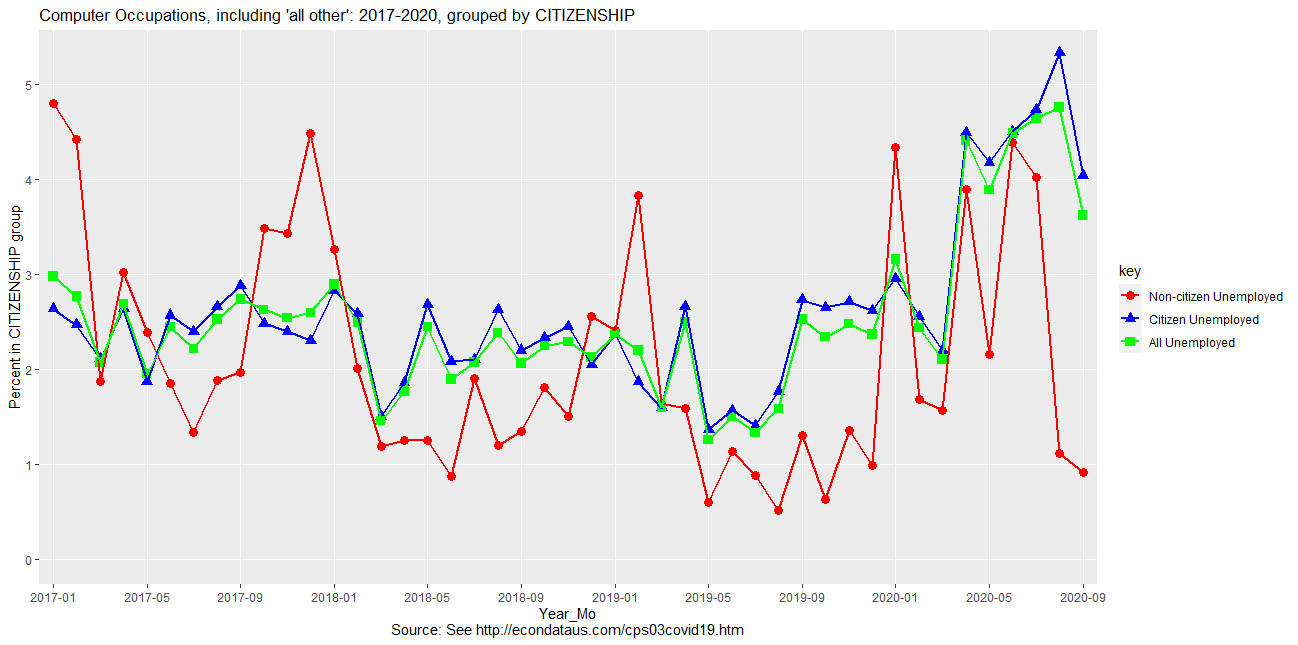
Computer Occupations, including 'all other': 2017-2020, grouped by CITIZENSHIP year_mo labor_force non_rate cit_rate all_rate non_count cit_count all_count 1 2017-01 4,685,816 4.8 2.6 3.0 35,608 103,944 139,552 2 2017-02 4,631,068 4.4 2.5 2.8 31,264 96,769 128,032 3 2017-03 4,498,666 1.9 2.1 2.1 12,341 80,915 93,256 4 2017-04 4,634,233 3.0 2.6 2.7 19,728 104,781 124,508 5 2017-05 4,498,814 2.4 1.9 2.0 16,358 71,373 87,731 6 2017-06 4,598,185 1.8 2.6 2.4 14,447 98,025 112,472 7 2017-07 4,512,675 1.3 2.4 2.2 10,290 89,706 99,996 8 2017-08 4,623,816 1.9 2.7 2.5 14,694 101,987 116,681 9 2017-09 4,716,498 2.0 2.9 2.7 15,191 113,710 128,901 10 2017-10 4,672,188 3.5 2.5 2.6 23,943 98,765 122,708 11 2017-11 4,917,446 3.4 2.4 2.5 23,590 101,252 124,842 12 2017-12 4,909,810 4.5 2.3 2.6 29,454 97,973 127,427 13 2018-01 5,091,390 3.3 2.8 2.9 23,571 123,616 147,187 14 2018-02 5,123,750 2.0 2.6 2.5 15,408 112,427 127,835 15 2018-03 5,049,461 1.2 1.5 1.5 9,243 64,204 73,447 16 2018-04 4,897,968 1.3 1.9 1.8 9,279 77,374 86,653 17 2018-05 4,944,899 1.3 2.7 2.4 10,227 110,594 120,821 18 2018-06 4,795,027 0.9 2.1 1.9 6,414 84,368 90,782 19 2018-07 4,891,323 1.9 2.1 2.1 14,578 86,841 101,420 20 2018-08 4,997,171 1.2 2.6 2.4 10,035 109,150 119,185 21 2018-09 4,866,778 1.3 2.2 2.1 10,777 89,525 100,303 22 2018-10 4,995,703 1.8 2.3 2.2 14,803 97,273 112,077 23 2018-11 5,055,289 1.5 2.4 2.3 12,677 103,087 115,764 24 2018-12 5,029,231 2.6 2.0 2.1 20,028 86,884 106,913 25 2019-01 4,947,938 2.4 2.4 2.4 19,223 98,116 117,339 26 2019-02 5,157,313 3.8 1.9 2.2 33,523 79,948 113,471 27 2019-03 4,965,726 1.6 1.6 1.6 13,177 66,263 79,440 28 2019-04 4,955,578 1.6 2.7 2.5 11,893 111,920 123,813 29 2019-05 5,061,264 0.6 1.4 1.3 4,205 59,402 63,607 30 2019-06 5,209,893 1.1 1.6 1.5 9,049 69,116 78,165 31 2019-07 5,386,494 0.9 1.4 1.3 6,843 64,925 71,768 32 2019-08 5,439,314 0.5 1.8 1.6 4,024 82,135 86,160 33 2019-09 5,279,188 1.3 2.7 2.5 9,879 123,347 133,225 34 2019-10 5,153,748 0.6 2.6 2.3 4,976 115,596 120,573 35 2019-11 5,142,270 1.4 2.7 2.5 11,913 115,492 127,405 36 2019-12 5,147,469 1.0 2.6 2.4 7,918 113,941 121,859 37 2020-01 5,476,662 4.3 3.0 3.2 35,387 137,614 173,001 38 2020-02 5,450,395 1.7 2.6 2.4 13,098 119,534 132,633 39 2020-03 5,421,957 1.6 2.2 2.1 12,903 101,111 114,014 40 2020-04 5,644,330 3.9 4.5 4.4 30,676 218,265 248,940 41 2020-05 5,682,895 2.2 4.2 3.9 17,633 203,287 220,920 42 2020-06 5,892,368 4.4 4.5 4.5 38,611 225,547 264,158 43 2020-07 5,807,555 4.0 4.7 4.6 29,463 239,978 269,441 44 2020-08 5,465,255 1.1 5.3 4.8 8,277 251,624 259,901 45 2020-09 5,022,122 0.9 4.0 3.6 6,063 175,728 181,792As can be seen, this definition shows a slightly higher unemployment rate of 3.6 percent for September for all workers in computer occupations and the same 4.0 percent for those who are U.S. citizens. Also, both of the above graphs and tables show that unemployment of U.S. citizens in computer occupations is higher than any of the pre-pandemic period back through at least 2017. It would seem very much a mistake to interpret the last one-month downtick in unemployment to these still high levels to mean that all employment problems have been resolved.
Note: The above two graphs and tables can be reproduced with the program in this section by changing line 40 from "maxmnth <- 5" to "maxmnth <- 9". In addition, the first graph and table are generated by uncommenting just the occt assignment on line 49, occt <- "Computer Occupations with managers (NFAP)". The second graph and table are generated by uncommenting just the occt assignment on line 45, occt <- "Computer Occupations, including 'all other'" and increasing ymax to 5.3 in order to display the new high level of unemployment.
Stuart Anderson Continues to Focus on January of 2020
On November 19, 2020, Forbes Magazine posted an article by Stuart Anderson titled Low Computer Unemployment Rate Could Affect H-1B Visa Court Cases. It begins:
The latest data from the Bureau of Labor Statistics show the unemployment rate in computer occupations is back where it was before the start of the coronavirus pandemic. An earlier court ruling found the Trump administration's arguments lacking when it cited unemployment data to justify new restrictions on H-1B visas. The latest statistics will make it more difficult for the administration to justify emergency regulations published in October on H-1B visas.
Further on, it states:
"In a return to pre-pandemic levels, the unemployment rate for individuals in computer occupations was 3.0% in October 2020, identical to the 3.0% unemployment rate in January 2020 (before the pandemic spread in the U.S.)," according to an analysis of the Bureau of Labor Statistics' (BLS) Current Population Survey by the National Foundation for American Policy (NFAP). "In a broader category, computer and mathematical occupations, the unemployment rate declined from 3.0% in January to 2.8% in October 2020, according to BLS."
By November 15, 2020, the Basic Monthly CPS data for October became available on the Census website. The following graph and table shows the updated results using Stuart Anderson's questionable definition of computer occupations.
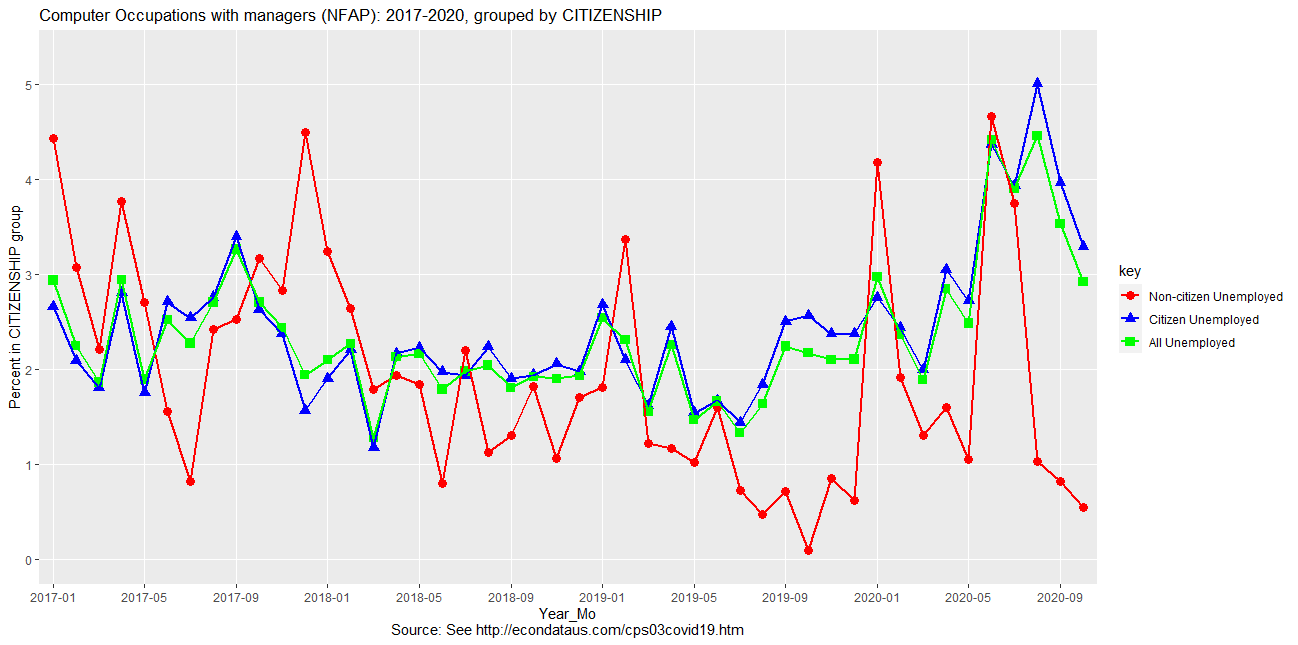
Computer Occupations with managers (NFAP): 2017-2020, grouped by CITIZENSHIP year_mo labor_force non_rate cit_rate all_rate non_count cit_count all_count 1 2017-01 5,083,329 4.4 2.7 2.9 35,608 113,686 149,294 2 2017-02 5,007,023 3.1 2.1 2.2 24,350 88,110 112,460 3 2017-03 4,921,265 2.2 1.8 1.9 16,225 75,456 91,681 4 2017-04 4,983,520 3.8 2.8 2.9 27,594 119,085 146,679 5 2017-05 4,887,519 2.7 1.7 1.9 19,922 72,621 92,543 6 2017-06 4,871,279 1.6 2.7 2.5 12,476 110,183 122,659 7 2017-07 4,777,019 0.8 2.5 2.3 6,121 102,340 108,461 8 2017-08 4,887,736 2.4 2.8 2.7 19,337 112,815 132,153 9 2017-09 4,941,581 2.5 3.4 3.3 19,055 142,162 161,217 10 2017-10 4,973,484 3.2 2.6 2.7 21,667 112,810 134,477 11 2017-11 5,097,665 2.8 2.4 2.4 20,012 104,162 124,173 12 2017-12 5,168,565 4.5 1.6 1.9 29,454 70,786 100,240 13 2018-01 5,204,071 3.2 1.9 2.1 24,481 84,624 109,104 14 2018-02 5,386,050 2.6 2.2 2.3 21,772 100,409 122,182 15 2018-03 5,341,738 1.8 1.2 1.3 15,174 52,967 68,141 16 2018-04 5,187,960 1.9 2.2 2.1 15,372 95,131 110,503 17 2018-05 5,241,516 1.8 2.2 2.2 15,664 97,719 113,383 18 2018-06 5,144,426 0.8 2.0 1.8 6,414 85,569 91,983 19 2018-07 5,142,346 2.2 1.9 2.0 18,644 83,032 101,676 20 2018-08 5,156,508 1.1 2.2 2.0 10,035 95,221 105,256 21 2018-09 5,004,165 1.3 1.9 1.8 10,777 79,570 90,347 22 2018-10 5,169,572 1.8 1.9 1.9 14,532 84,735 99,267 23 2018-11 5,186,986 1.1 2.1 1.9 8,745 89,765 98,510 24 2018-12 5,234,781 1.7 2.0 1.9 14,178 86,988 101,166 25 2019-01 5,154,654 1.8 2.7 2.5 15,205 115,648 130,854 26 2019-02 5,429,520 3.4 2.1 2.3 30,370 94,890 125,260 27 2019-03 5,271,519 1.2 1.6 1.6 10,295 71,602 81,897 28 2019-04 5,221,387 1.2 2.4 2.3 9,135 108,711 117,846 29 2019-05 5,413,793 1.0 1.5 1.5 7,897 71,472 79,369 30 2019-06 5,406,565 1.6 1.7 1.7 13,725 76,018 89,743 31 2019-07 5,533,182 0.7 1.4 1.3 6,052 67,442 73,495 32 2019-08 5,630,362 0.5 1.8 1.6 4,024 87,974 91,998 33 2019-09 5,410,845 0.7 2.5 2.2 5,701 115,425 121,126 34 2019-10 5,311,873 0.1 2.6 2.2 828 114,536 115,363 35 2019-11 5,301,418 0.8 2.4 2.1 7,978 103,430 111,408 36 2019-12 5,269,303 0.6 2.4 2.1 5,037 105,728 110,765 37 2020-01 5,540,113 4.2 2.8 3.0 35,387 129,266 164,653 38 2020-02 5,602,755 1.9 2.4 2.4 14,942 117,460 132,402 39 2020-03 5,794,298 1.3 2.0 1.9 11,458 97,810 109,268 40 2020-04 5,955,976 1.6 3.1 2.8 13,588 155,760 169,348 41 2020-05 6,030,322 1.0 2.7 2.5 8,921 140,820 149,741 42 2020-06 6,310,136 4.7 4.4 4.4 44,361 234,111 278,472 43 2020-07 6,044,541 3.7 3.9 3.9 29,628 206,333 235,961 44 2020-08 5,875,240 1.0 5.0 4.5 8,277 253,568 261,845 45 2020-09 5,367,953 0.8 4.0 3.5 6,063 183,429 189,492 46 2020-10 5,407,741 0.5 3.3 2.9 3,997 153,871 157,867As can be seen, Anderson's questionable definition shows that the unemployment rate of computer occupations was at about the same 3.0 percent in January and October (actually 2.9 percent in October) as mentioned in the Forbes article. Looking just at computer occupations held by U.S. citizens, however, the unemployment rate rose from 2.8 percent in January to 3.3 percent in October, a rise of half of a percent. Also, the data shows that January experienced a local peak in unemployment. The unemployment rate for computer occupations held by U.S. citizens was 2.8 percent in January but 2.4 percent in the previous and following months. Hence, it would appear that Stuart is engaging in a little bit of cherry-picking to make his argument look better. This likely also explains why he did not write any analyses of the unemployment rate of computer occupations in June through August when it spiked at over 4 percent. It seems especially irresponsible to create a measure of unemployment that nobody else can likely calculate (though I made the effort to do so) and then not provide all of its values over time, allowing you to cherry-pick at will to strengthen your arguments.
In any event, the table above shows some other interesting facts. The number of unemployed U.S. citizens who worked in computer occupations reached a local high of 129,266 in January, dropped to a low of 97,810 in March and is now at 153,871. It's current level is still higher than any pre-pandemic level, at least back to January of 2017. This helps to make the point that the unemployment rate is an imperfect measure. A couple of ways in which it is imperfect are described in the following excerpt about a description of Weaknesses of Unemployment Statistics:
The unemployment data have a number of problems that lead to an understatement of unemployment. For example, the data count as employed all people who are working part time but who would like to work full time. Since these people represent unused labor effort that is available, the unemployment rate understates the extent of unemployed resources in the economy. Another problem that causes the unemployment rate to understate the extent of unemployed resources is the "discouraged-worker" effect. If someone wants to work, but becomes so convinced that there are no jobs available that he makes no effort to find work, he will be counted as "not in the labor force." Since there will be more discouraged workers the more severe the recession, this factor will tend to dampen the fluctuations in the unemployment rate.
The phenomena of the "discouraged worker" would also seem to apply to workers who attempt to find a job in the computer industry and finally become discouraged and take a job in another industry. This is described in the red text in the Summary below.
Note: The above graph and table can be reproduced with the program in this section by changing line 40 from "maxmnth <- 5" to "maxmnth <- 10". In addition, the graph and table are generated by uncommenting just the occt assignment on line 49, occt <- "Computer Occupations with managers (NFAP)".
Summary of Stuart Anderson's Errors about the Unemployment Rate for Computer Occupations
Stuart Anderson has made the following three major errors in his May 18th and June 11th editorials in Forbes:
Finally, both editorials make a major point of comparing the unemployment rates of computer occupations to the much higher unemployment rates of all other occupations. This is a serious mistake. Suppose that U.S. employers are discriminating against U.S. workers due to race, gender, and/or age or because they perceive those workers to be more independent and/or higher paid. What will those workers do? If they need income to survive, younger workers will likely accept jobs in other, lower-paid fields while continuing to look for computer work. Older workers may essentially give up and move to another field or retire. Both the younger and older workers will disappear from the unemployment roles. A worker who is unemployed from ALL occupations is a very different matter. They will show up in the overall unemployment rate and in the unemployment rate of whichever occupation they identify as their current one. Hence, it's very much a mistake to treat the unemployment rate of a specific occupation the same as the overall unemployment rate. It may be useful in measuring an economic shock to an occupation that causes sudden, temporary unemployment. But it likely will not be able to detect if there is systemic bias against classes of workers and that those workers are driven out of the field.
You can reproduce any of the above numbers via the R program at this link. That program uses publicly available data on the Census website.